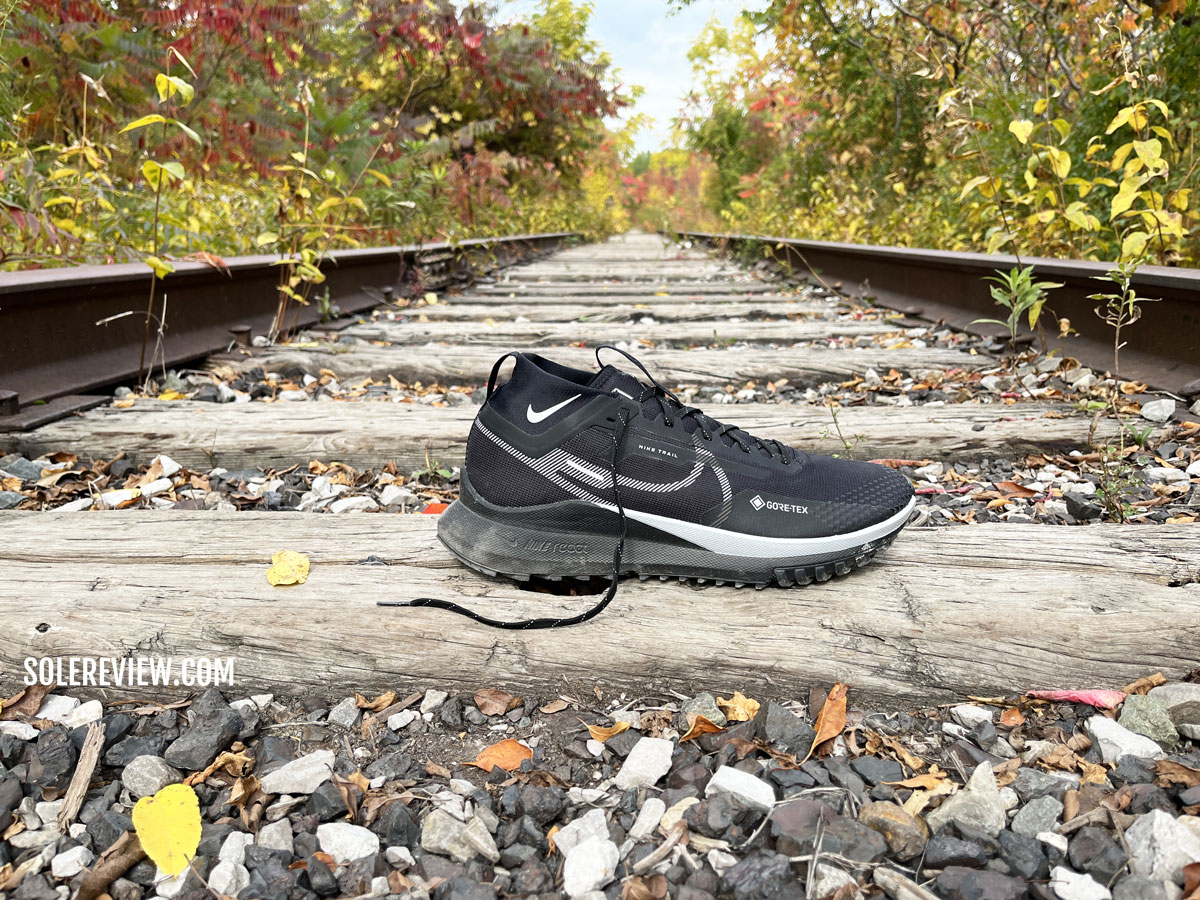
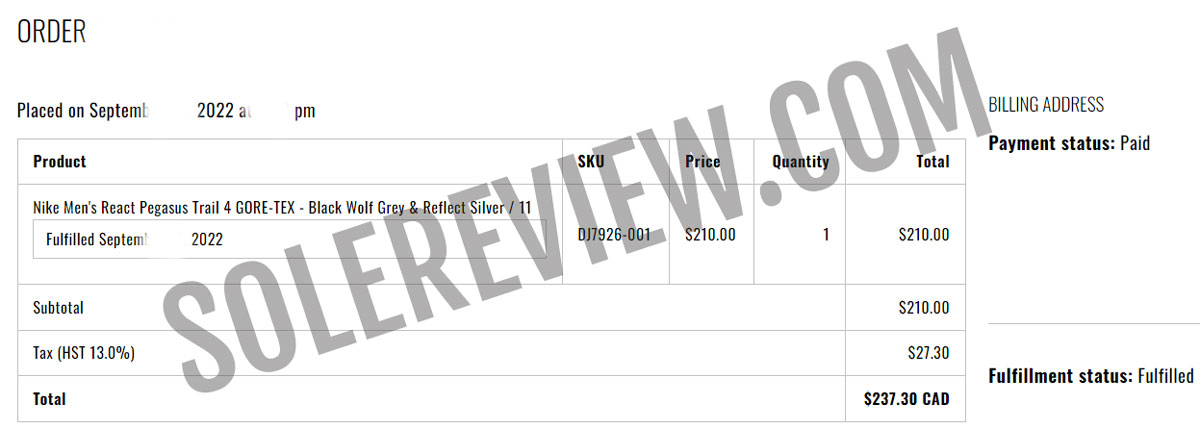
The Nike Pegasus Trail 4 Gore-Tex was purchased at full retail price for our review. The amount is in Canadian Dollars.
In this review:
THE SUMMARY
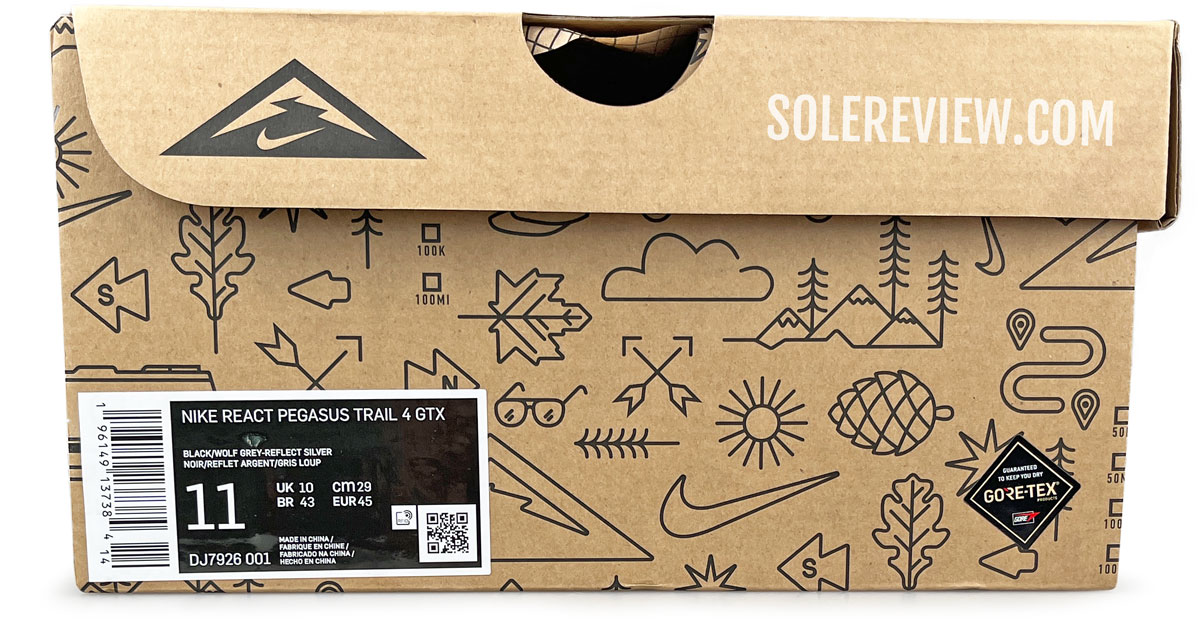
Which shoe is softer – the Pegasus Trail 4 or Pegasus 39? You’d be surprised by the answer.
Here’s an interesting fact about the Nike Pegasus Trail 4; it has a softer ride than the standard Pegasus 39.
Not that the Pegasus Trail shares any parts with the 39; this is a completely different product with a rugged, outdoors-focused design. At the same time, the Pegasus Trail 4 isn’t a serious trail-vanquishing shoe either.
So what kind of shoe is the Nike Pegasus Trail 4?
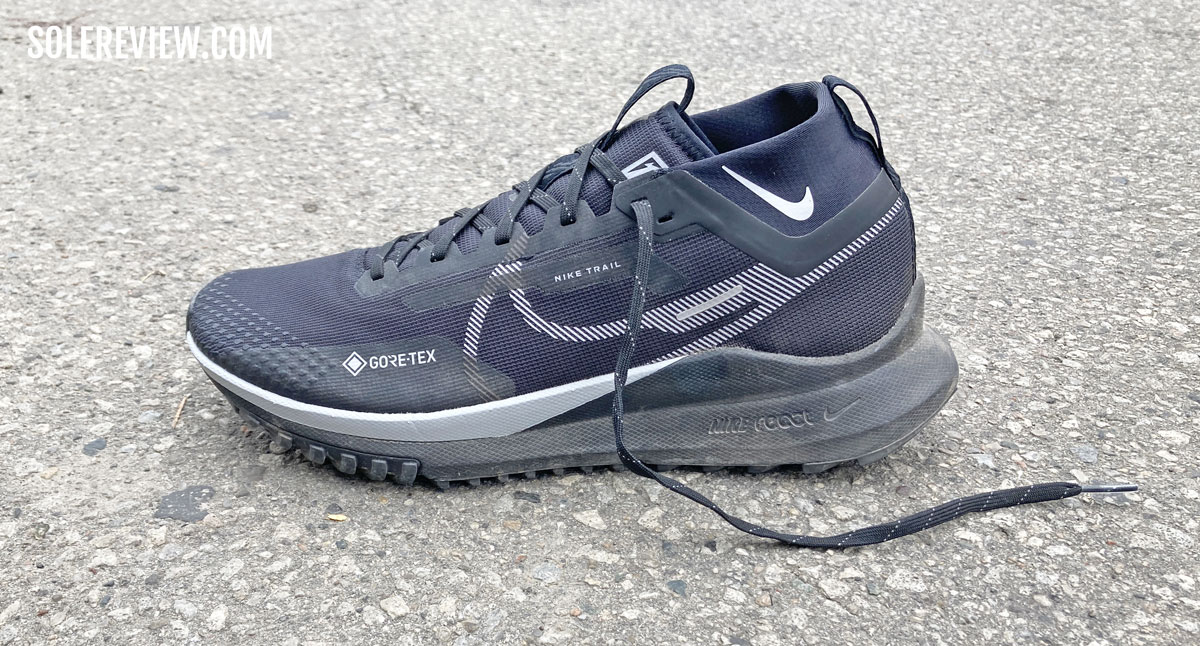
The soft cushioning makes it optimal for road runs.
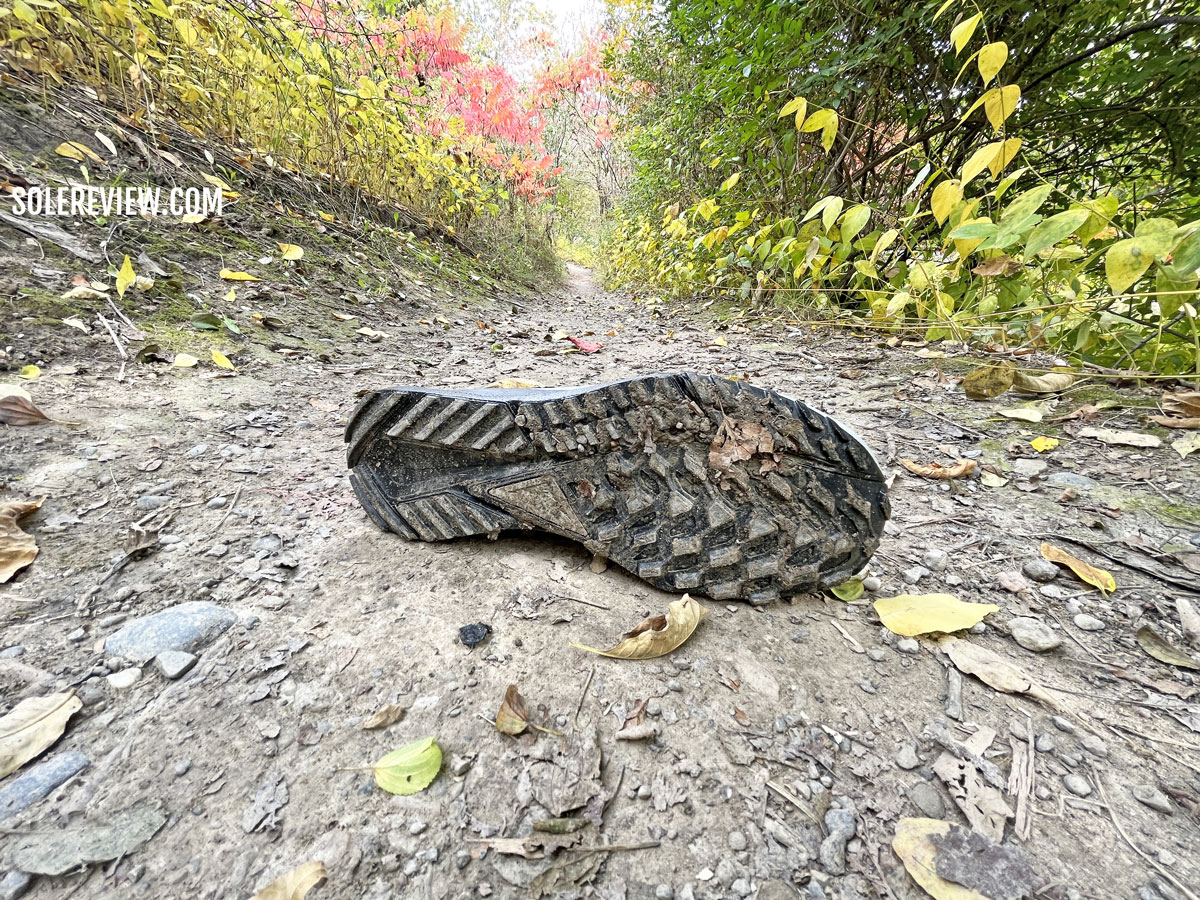
As long as the trails are flat and non-technical, the shoe performs as advertised. The ride stability is a limitation on challenging trails.
Let’s say you want to go for a run, and are unsure of what your route is going to be. So off you go out the door, and onto the concrete sidewalks. Twenty minutes into the run, you decide to take a detour through a gravel path or packed trail.
And if you’re running in the Nike Pegasus Trail 4, this transition would pose no challenge at all.
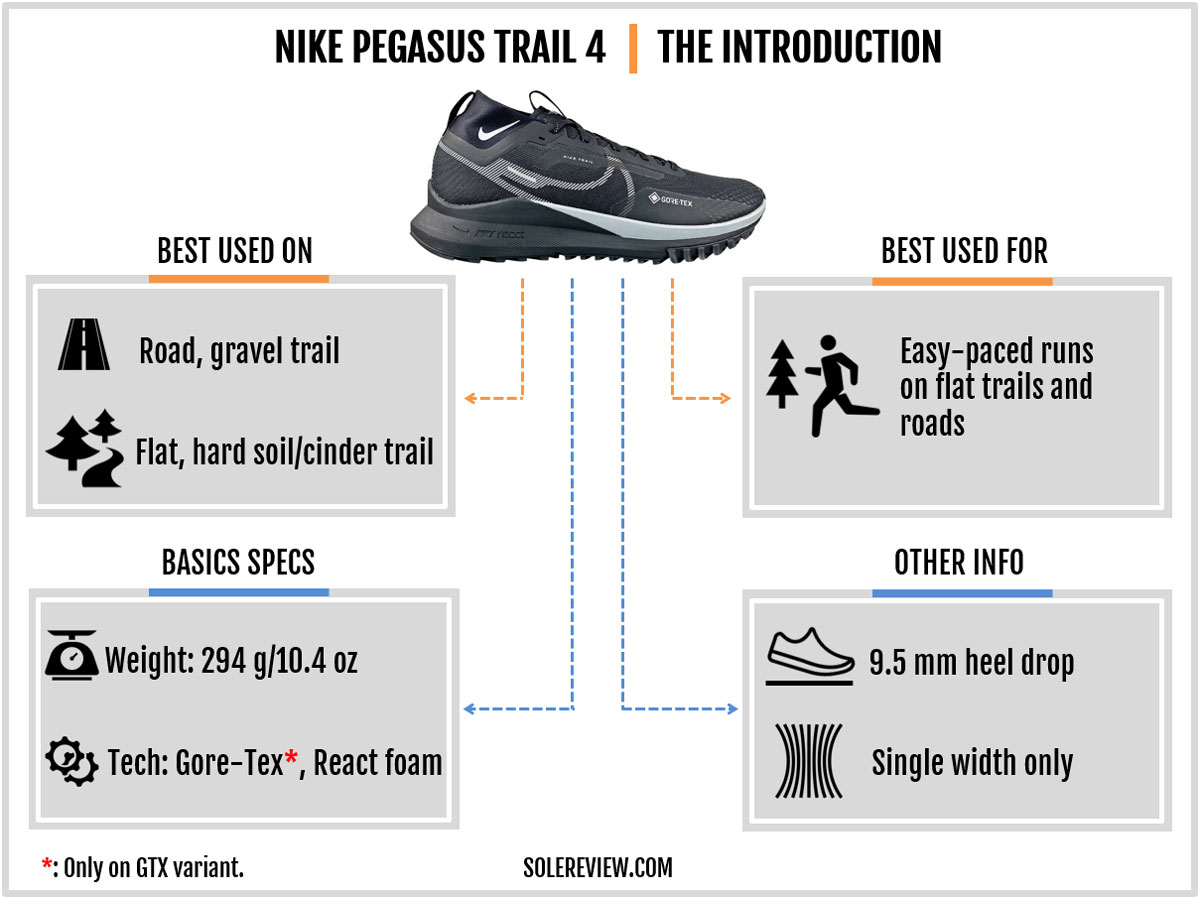
On paved surfaces, the soft cushioning provides plenty of comfort to keep you going for miles. And if you decide to step off the road and cut across a park or forested ravine, the outdoors-oriented features of the Pegasus Trail 4 kicks in.
In short, the Nike Pegasus Trail 4 is a useful on-road, off-road shoe. The other shoe that comes to mind is the New Balance Hierro V7, but the trail capabilities of the Pegasus Trail are several rungs below the Hierro.
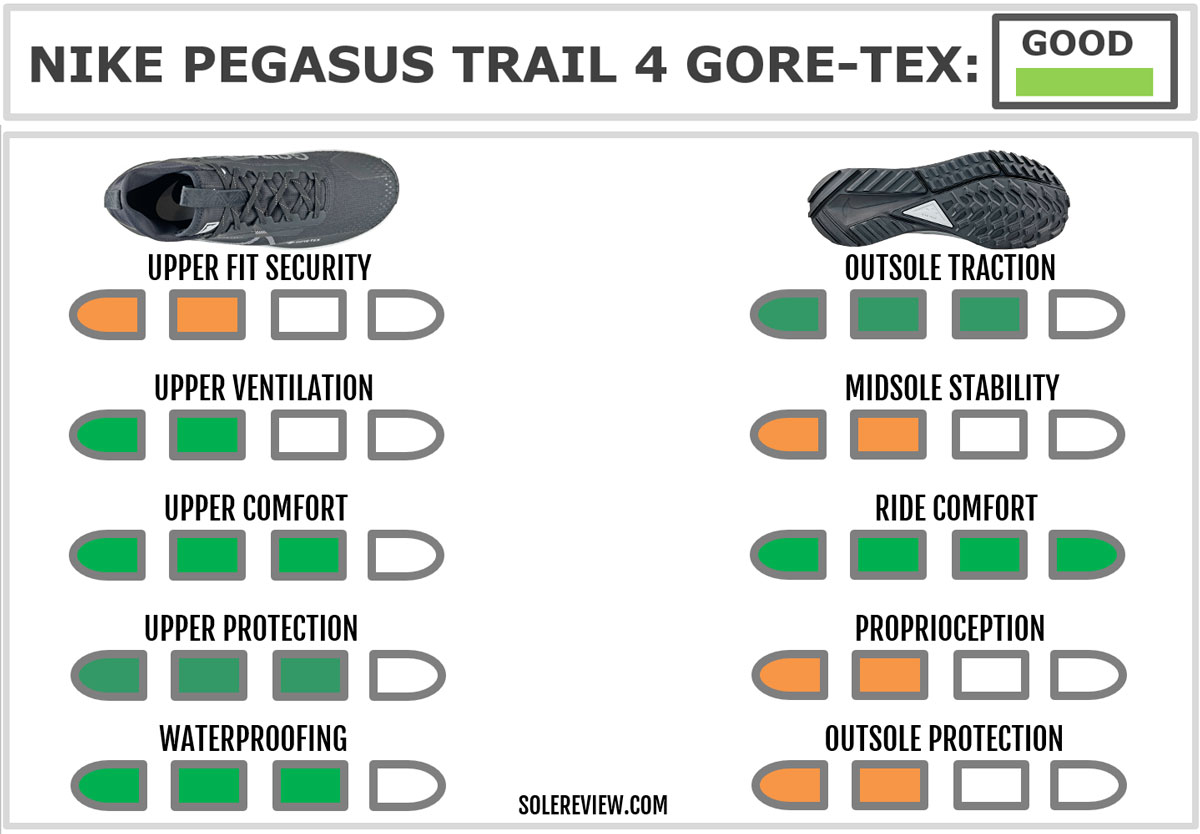
We say this because its soft ride and lack of protective features like a rock shield make it unsuitable for technical terrains.
The upper also lacks a gaiter attachment point and has a relaxed midfoot fit – if you’re buying the Gore-Tex version, that is.
The standard Pegasus Trail 4 differs from its waterproof variant with a more secure midfoot and true to size fit. We’ll cover the difference in our fit section.
COMPARISON: THE NIKE PEGASUS TRAIL 4 VERSUS NIKE PEGASUS TRAIL 3
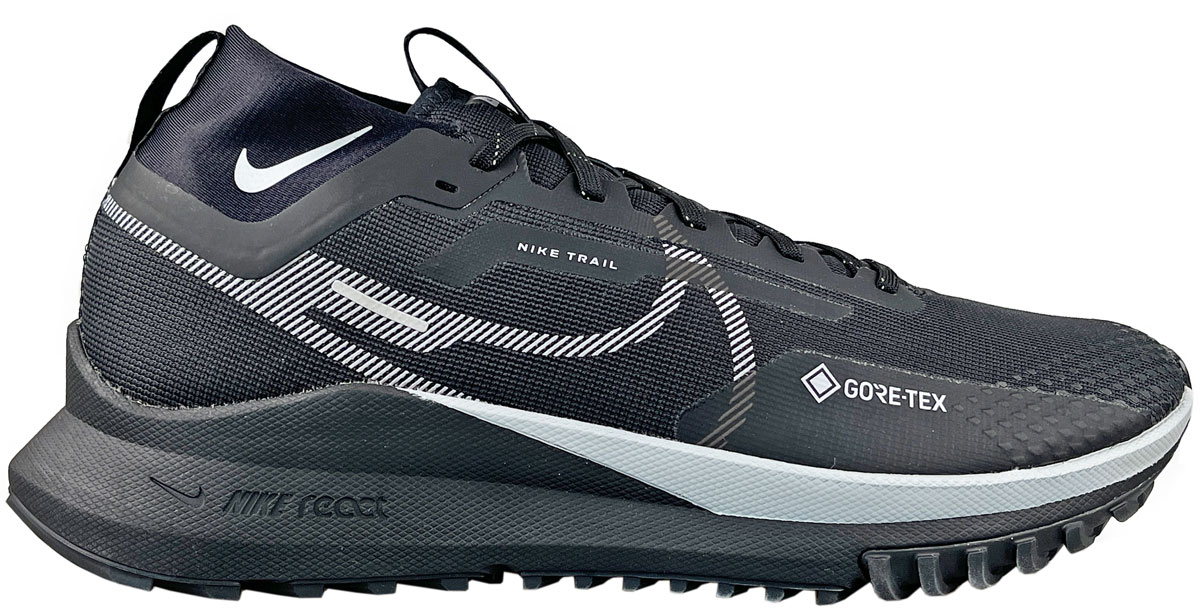
The 2022 model is softer and lighter.
The Pegasus Trail 4 is back to its Pegasus 36 Trail origins – both from an outsole and upper perspective. It ditches the single-piece outsole of the Pegasus Trail 2 and 3, as well as the protective toe bumper wrap.
On the upper, the Flywire-assisted midfoot is back on the non-GTX model. That means that the redesigned upper (of the non-GTX model) does away with rubberized panels and loops that existed on the V3.
The toe-box isn’t as protective as the last version, because the unique rubber bumper has been replaced with a shorter lip.
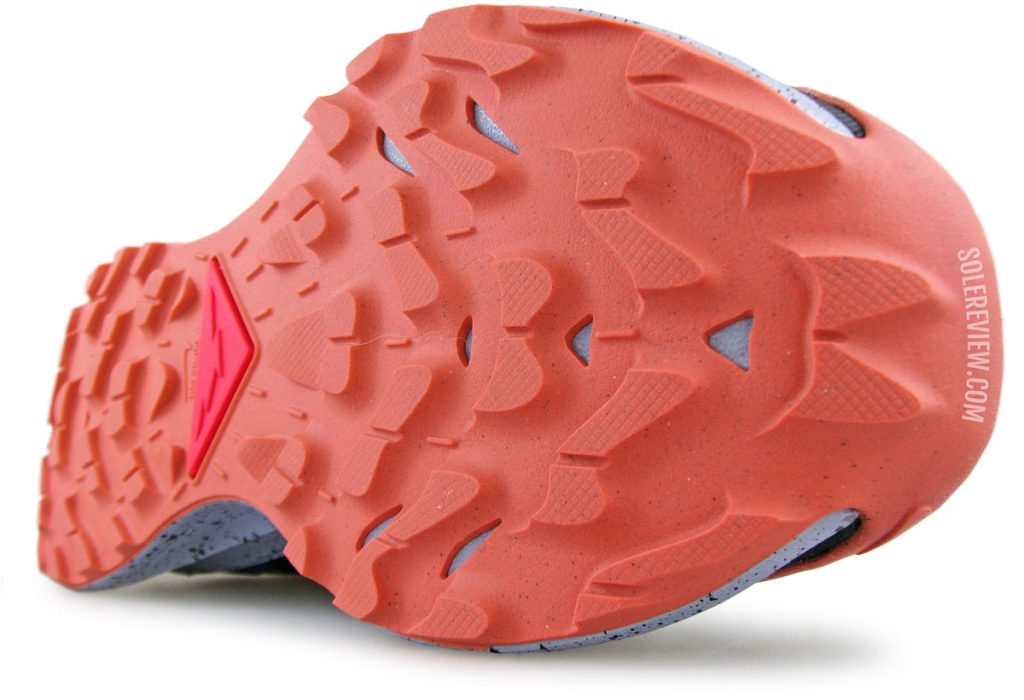
This was the outsole of the last year’s model. The V4 swaps the single-piece design with an articulated layout.
From a ride viewpoint, the Pegasus Trail 4 is as comfortable as the Trail 3, but with notable changes. The midsole is softer, and slightly less supportive. On one hand, the higher sidewalls do not have the scooped design of the V3 and do a better job of cupping the foot.
The higher level of softness comes from the multi-piece outsole that allows the midsole to flex better. There’s now a negative space under the heel that also increases the cushioning softness when loaded – something that the Pegasus Trail 3 did not have. The lighter outsole helps the V4 shed nearly an ounce over the V3.
On the flip side, the softer ride and lower outsole coverage decrease the overall stability.
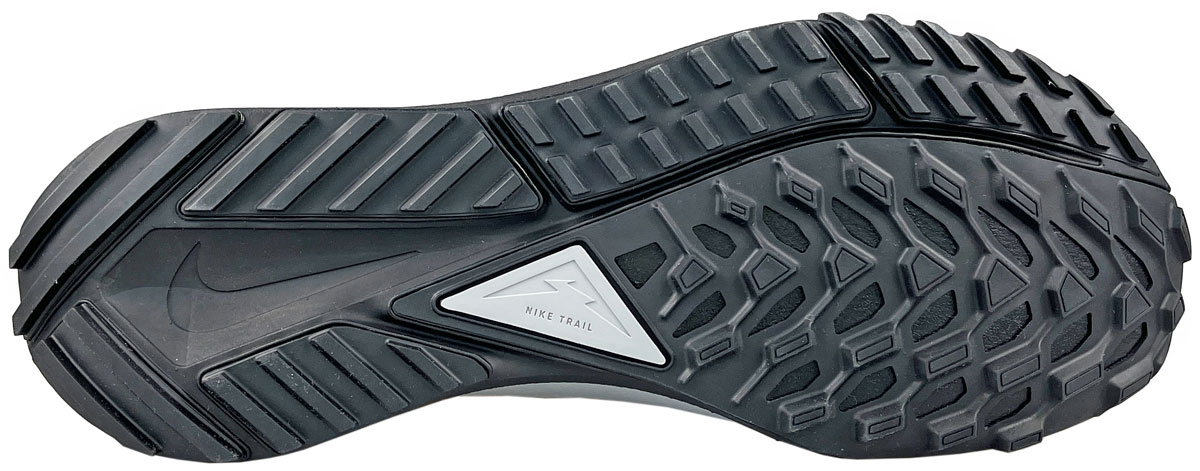
The new outsole geometry has less aggressive lugs and exposes more soft midsole foam.
With a milder outsole geometry, the Pegasus Trail 4 is a lesser trail shoe than the previous model. The thin outsole doesn’t offer much in the way of protection, and the thin sheet of rubber appears to have lower durability.
On the bright side, the thin rib-like lugs provide a much better grip on downhill sections.
COMPARISON: THE NIKE PEGASUS TRAIL 4 GTX VERSUS NIKE PEGASUS TRAIL 4
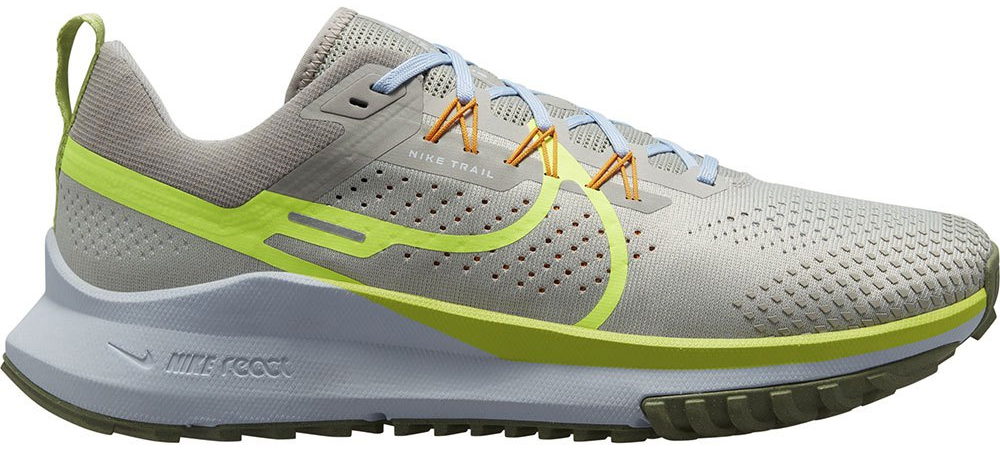
The standard variant has a Flywire midfoot with fewer overlays.
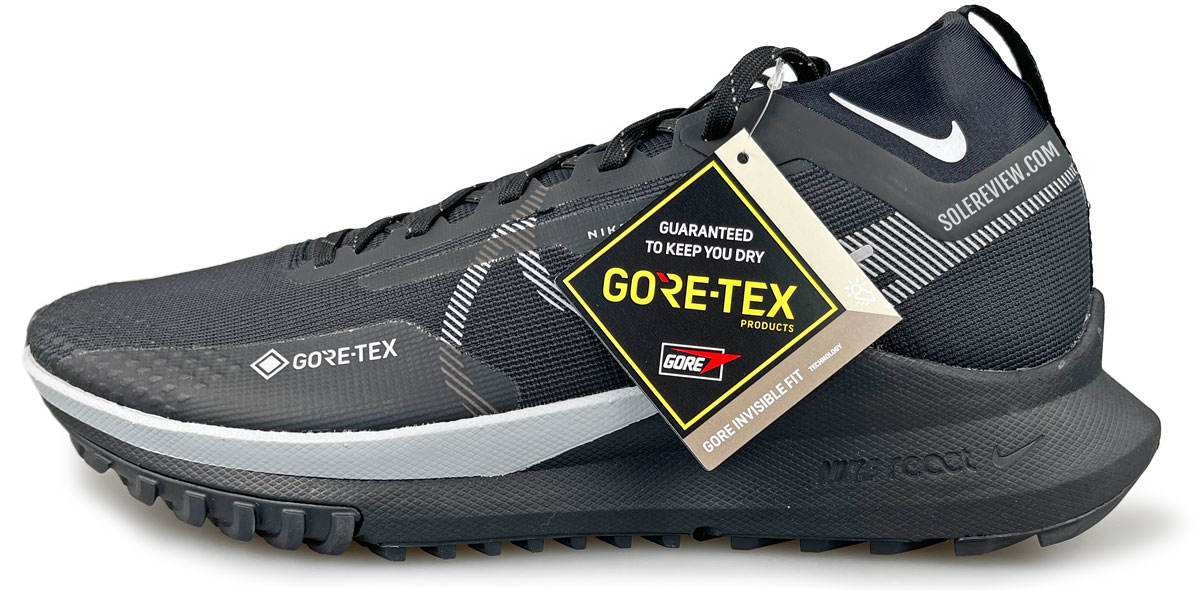
The GTX upper differs from the non-waterproof version in many ways – and that includes how it fits.
Like every year, Nike sells two versions of the Pegasus Trail. There’s the standard variant and the waterproof Gore-Tex version. Both the models share the same midsole, insole, and outsole, so there’s no difference in the ride quality.
However, the upper fit is where the regular model differs vastly from the GTX version.
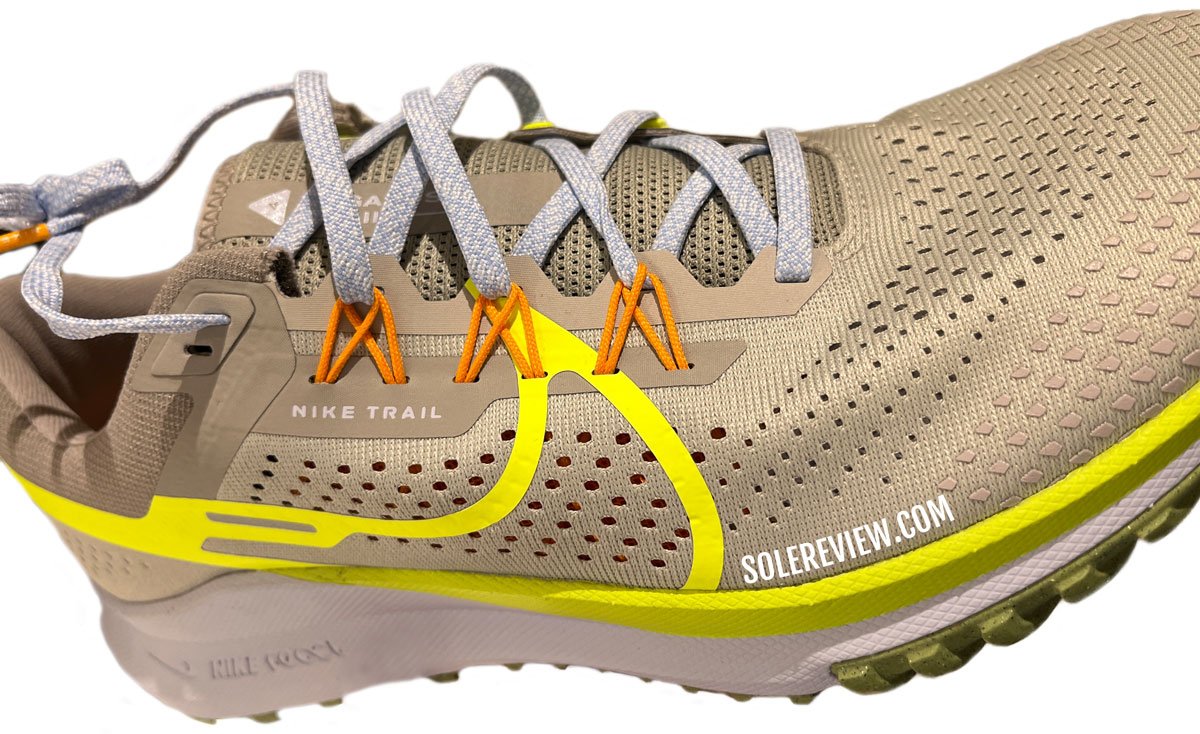
The standard Pegasus Trail 4 has Flywire cords and fewer overlays. While shallow in the front, the fit is true to size – unlike the Gore-Tex model.
Unlike the latter, the standard Pegasus Trail 4 has a Flywire lacing system that delivers a much higher level of fit security. In contrast, the Gore-Tex upper is too roomy around the midfoot, and it’s hard to get a locked-down feel.
The GTX upper also has a heel gaiter or sleeve, a feature that the Pegasus Trail 4 lacks.
As a result, the heel padding is configured differently on the GTX model than on the standard Pegasus Trail 4. The collar padding inside the GTX upper is more aggressive, and that tends to reposition the foot forward.
And most of us know what happens next – the GTX version fits slightly shorter. In other words, if you buy a US 10 in the regular Pegasus Trail 4, you’ll need to get a US 10.5 in the GTX model.
THE MIDSOLE DESIGN AND RIDE EXPERIENCE
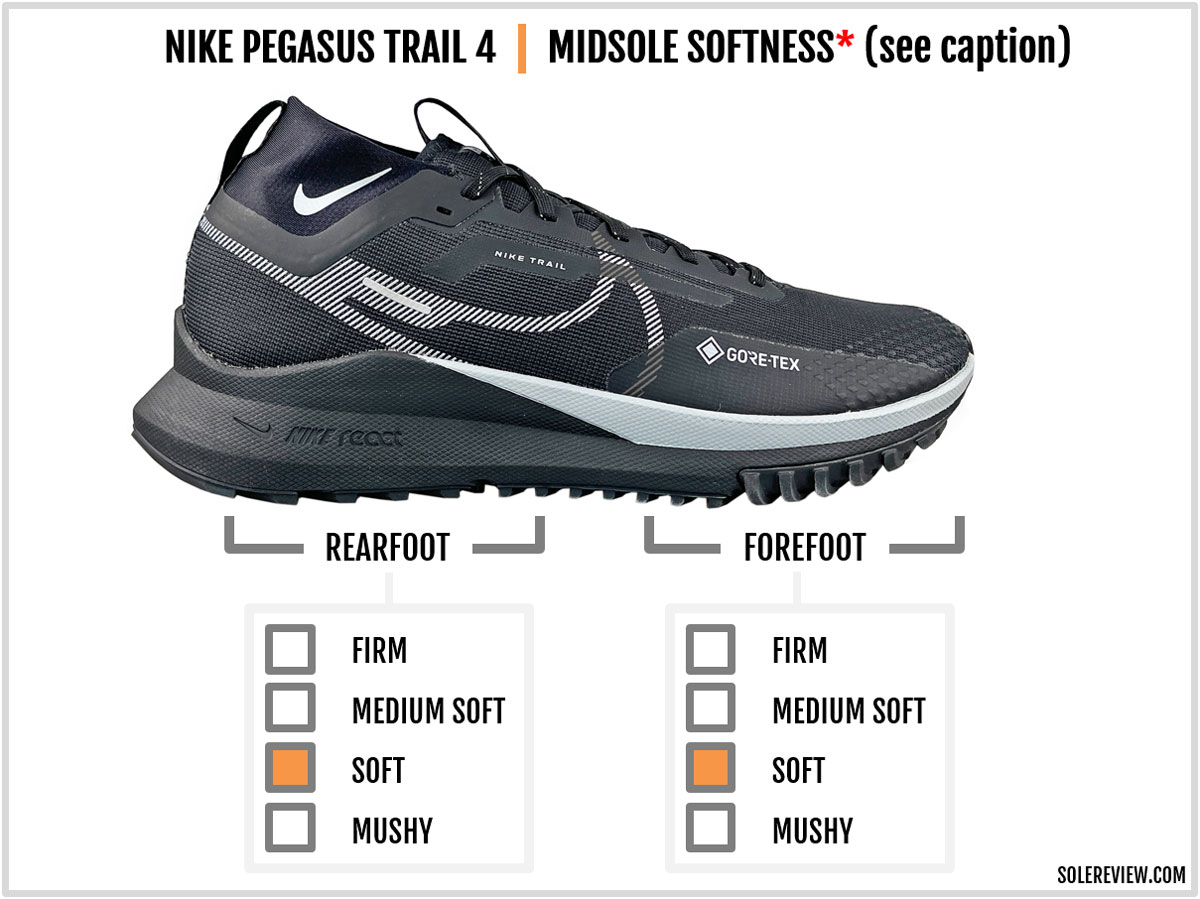
*The React foam hardens in freezing temperatures.
If you own a pair of the Pegasus 39 but have never run in the trail version, you’d be surprised to know that the Pegasus Trail 4 is softer than the Pegasus 39.
While counterintuitive, the reason is fairly simple. Unlike the Pegasus 39’s Zoom Air-equipped midsole, the Pegasus Trail 4’s cushioning is derived entirely from a React foam stack. A pressurized Zoom Air bag is stiff, so not having them naturally increases the ride softness.
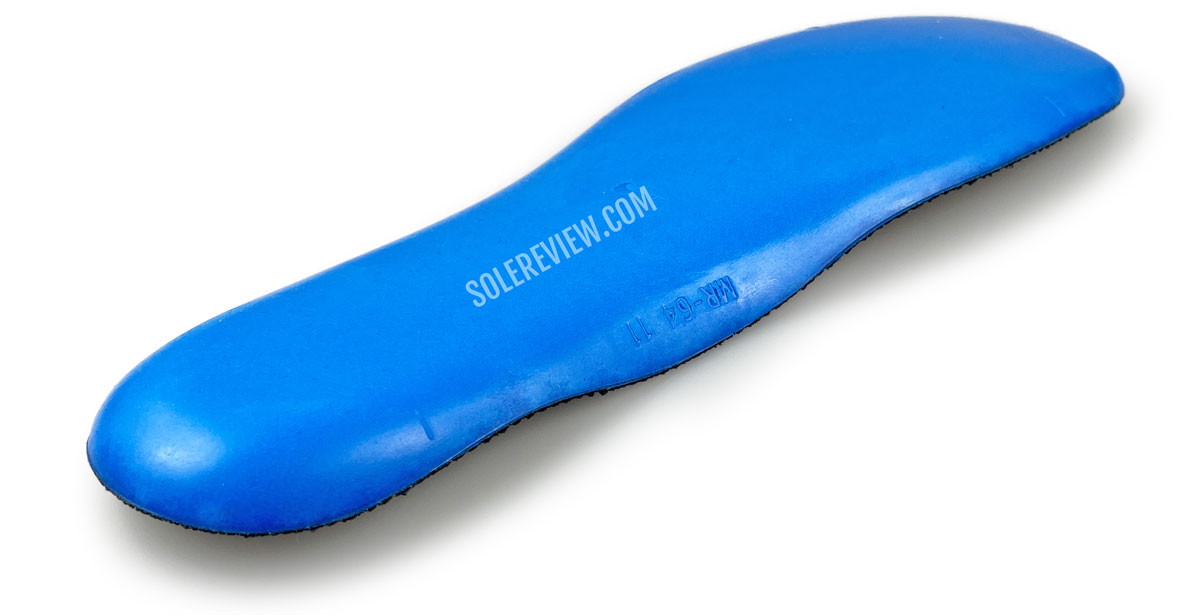
New shoe, new insole. The smoother foam footbed is denser and more responsive than the old one.
The Pegasus Trail 4 also has another component that’s missing on the Pegasus 39. The removable insole is made of a smooth EVA(?) foam blend that enhances the cushioning experience.
The changes made to the outsole also add softness, and these are the qualities that make the Pegasus Trail 4 a decent road-trail hybrid.
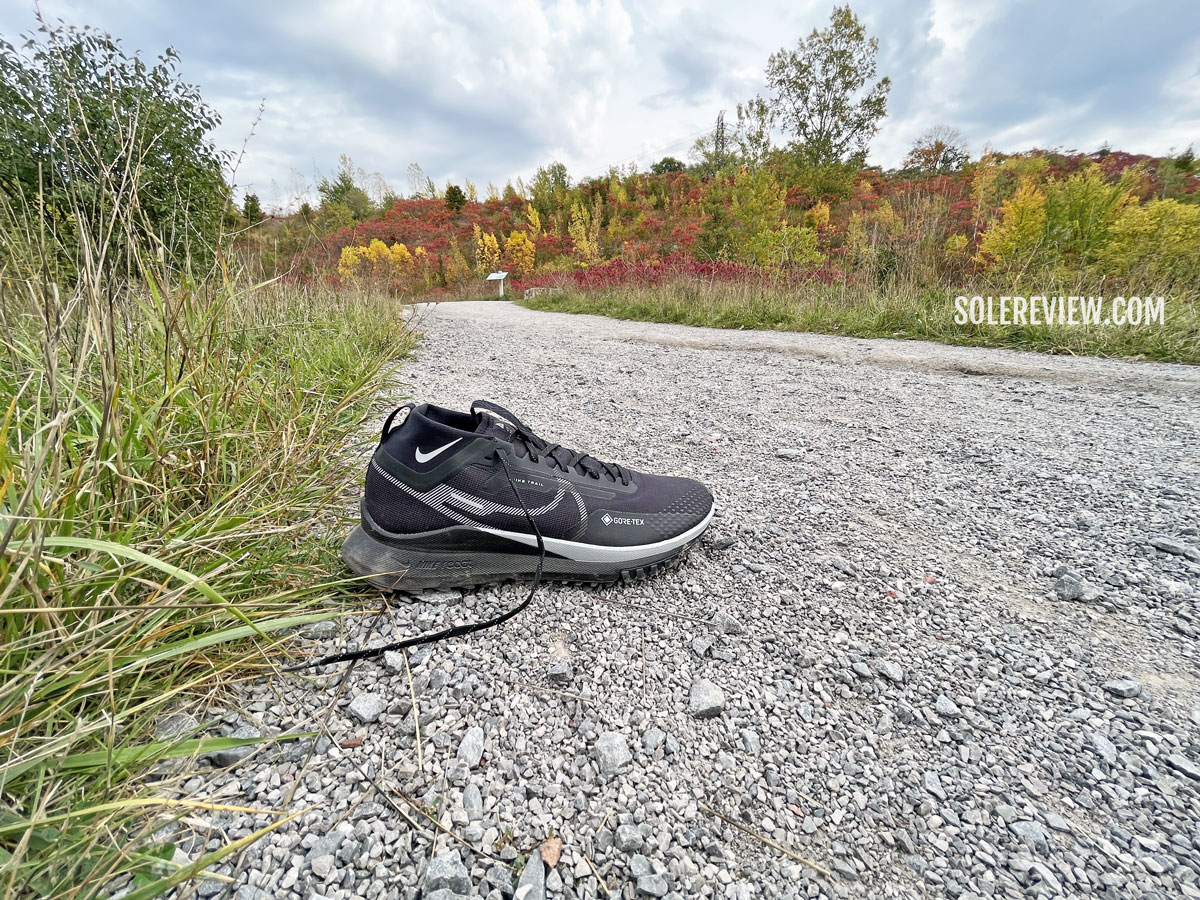
There’s a good reason why this shoe is known as a road-trail hybrid. It’s closer to a road shoe than a serious trail runner. It does best on flat terrain – like this gravel path, for example.
As long as the off-road surface doesn’t involve a high level of proprioception or protection requirements, the Pegasus Trail 4 works perfectly well. The comfortable React midsole means that 5K to 10K runs (or longer) on gravel flats, packed trails, or roads do not feel harsh.
The new outsole also exposes the React midsole in high-impact loading zones, and that leads to a marked increase in ride softness. Unlike the Pegasus Trail 3, the hollow space under the heel (where the Nike logo is) allows the midsole to splay wide when loaded.
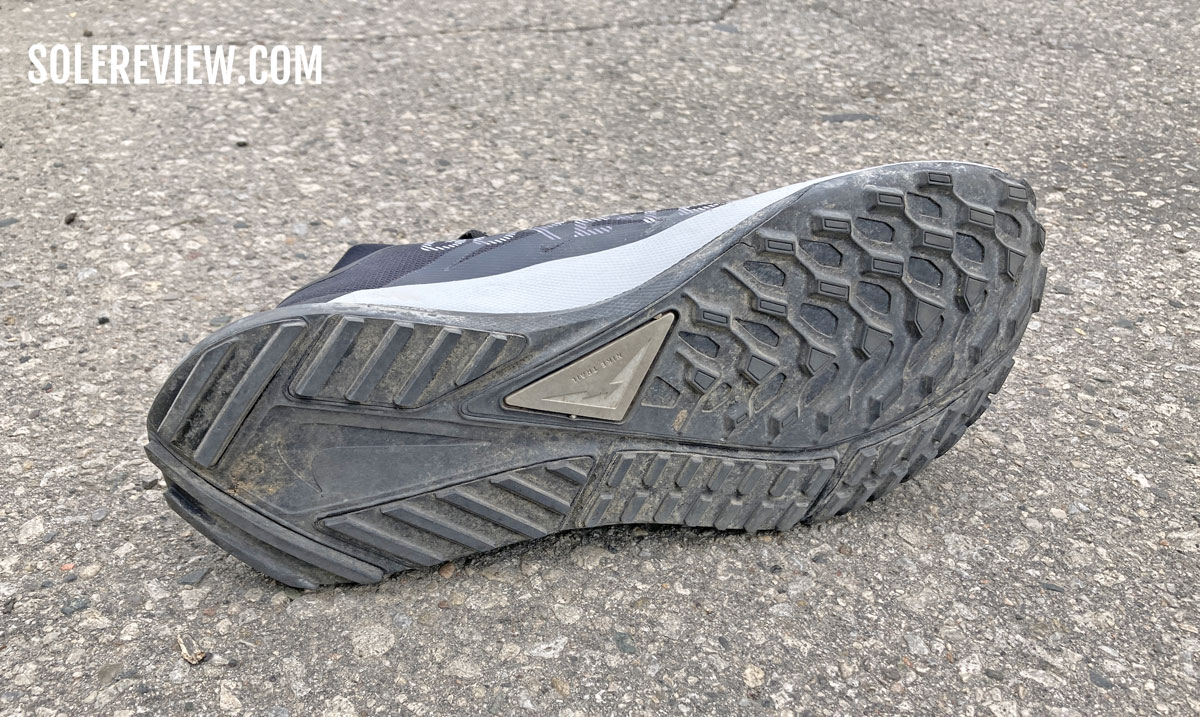
The cushioned midsole offers a high level of on-road comfort.
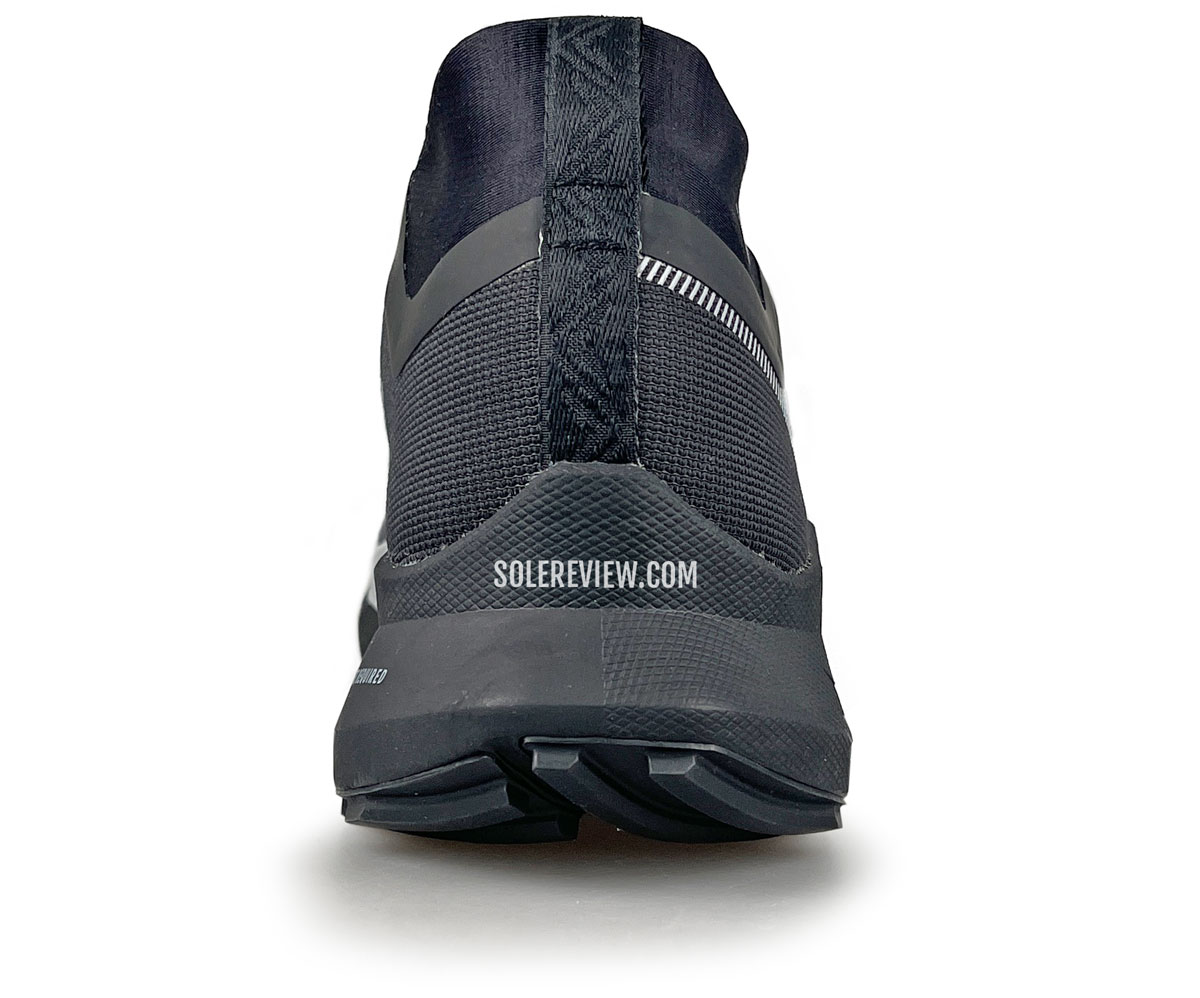
The Pegasus Trail 4 isn’t stable on uneven trails, but does okay on roads and mild gradients.
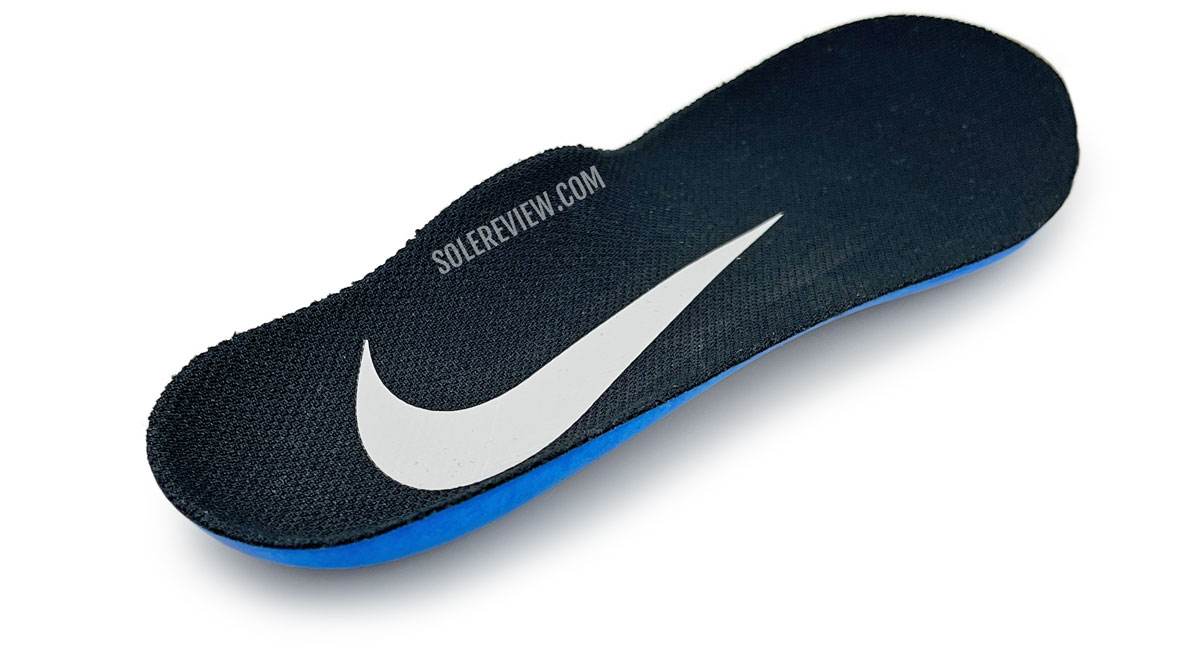
The molded insole has a flared arch.
On mild gradients and flats, the midsole is fairly supportive. The elevated sidewalls create a higher level of cupping action around the midfoot, and the insole flare produces a sensation of under-arch support.
It’s worth noting that the non-GTX model has a higher level of under-arch support, as the insole works together with the Flywire cords to hug the midfoot. The waterproof upper does not have this advantage due to a different lacing system.
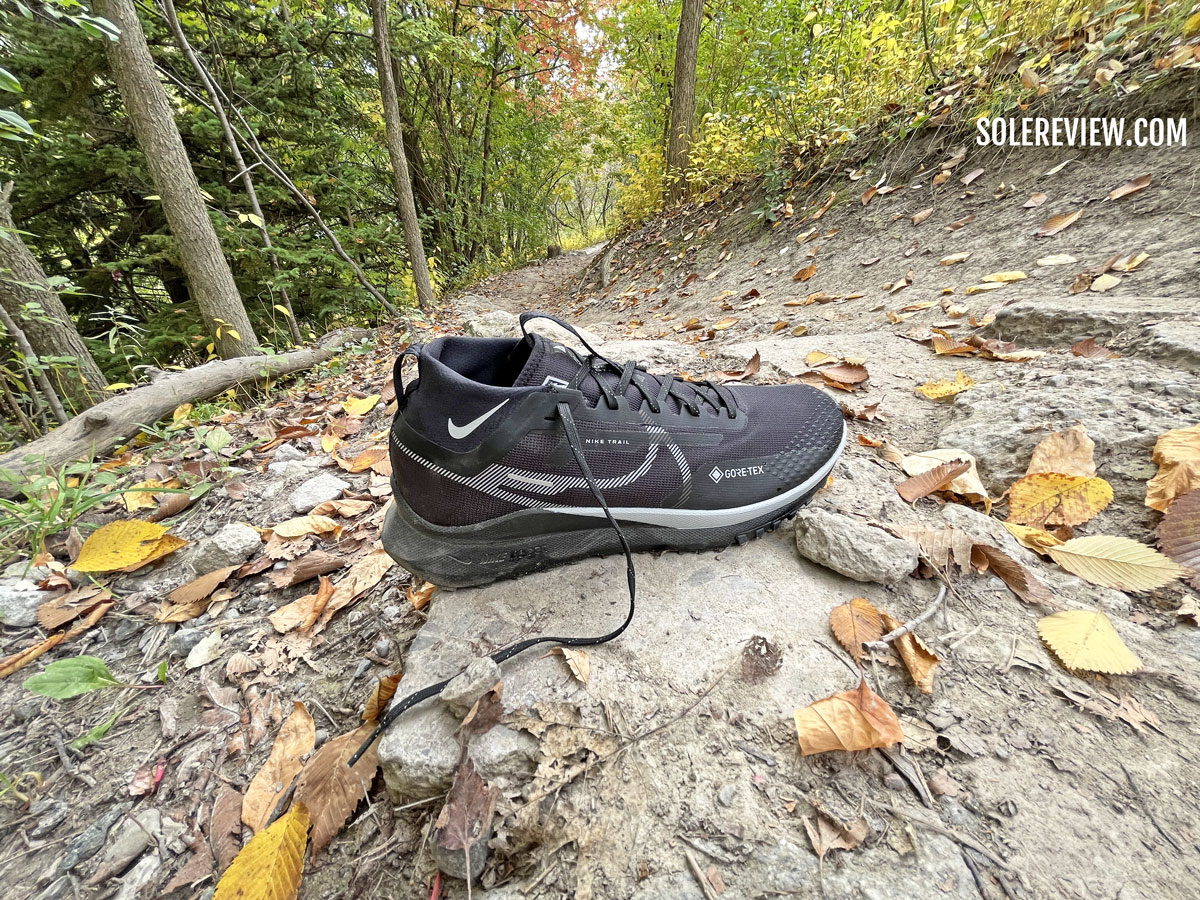
The Nike Pegasus Trail 4 struggles to find its footing on steep and uneven terrain.
The same qualities that make this product an excellent road running shoe also work against it on technical terrain.
Of course, the term ‘technical’ could mean anything from a muddy or clay-type surface to an unpredictable route with steep grades, narrow paths, and obstacles.
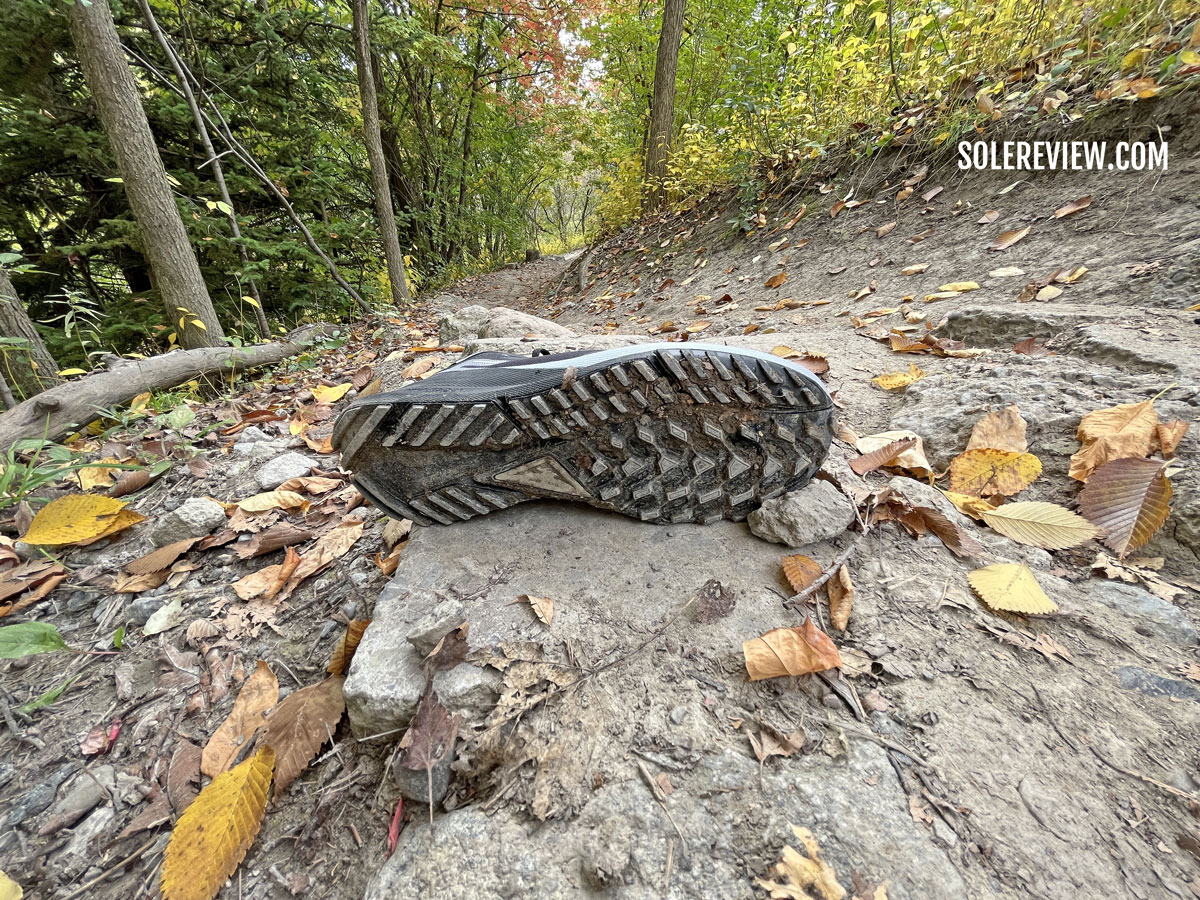
The soft ride, low stability, and lack of protection get in the way.
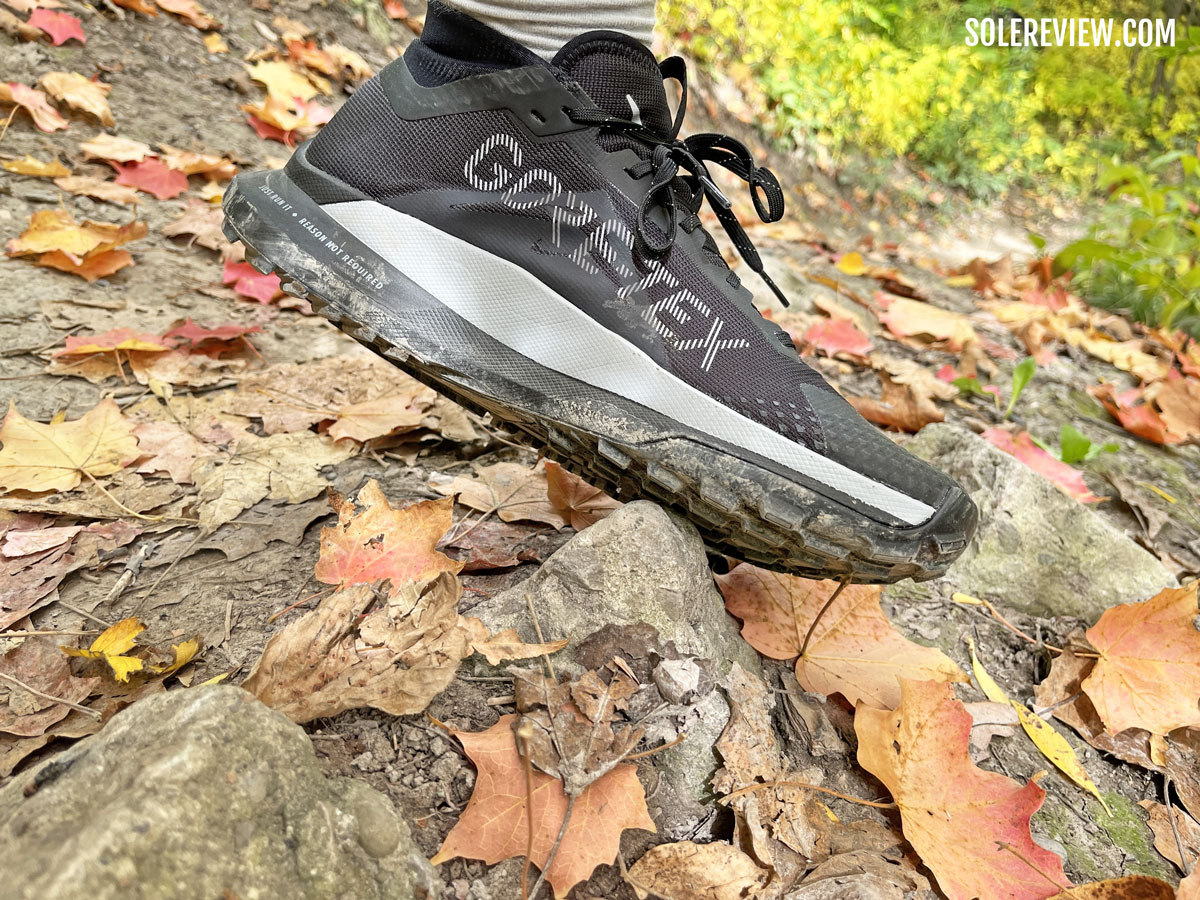
You can feel every pointy rock and root. The last year’s model did better in this area due to the greater outsole coverage.
This is where the Pegasus Trail 4 struggles. The perforated forefoot outsole offers barely any protection, so you can feel every pointy root and rocky on the path. There is no rock-plate, just the thin outsole and React foam.
The midsole softness and thickness also get in the way of proprioception, so precise footing on technical terrain is not something that the Pegasus Trail 4 does well. The same goes for speed – the low level of stability and proprioception are barriers to building up pace.
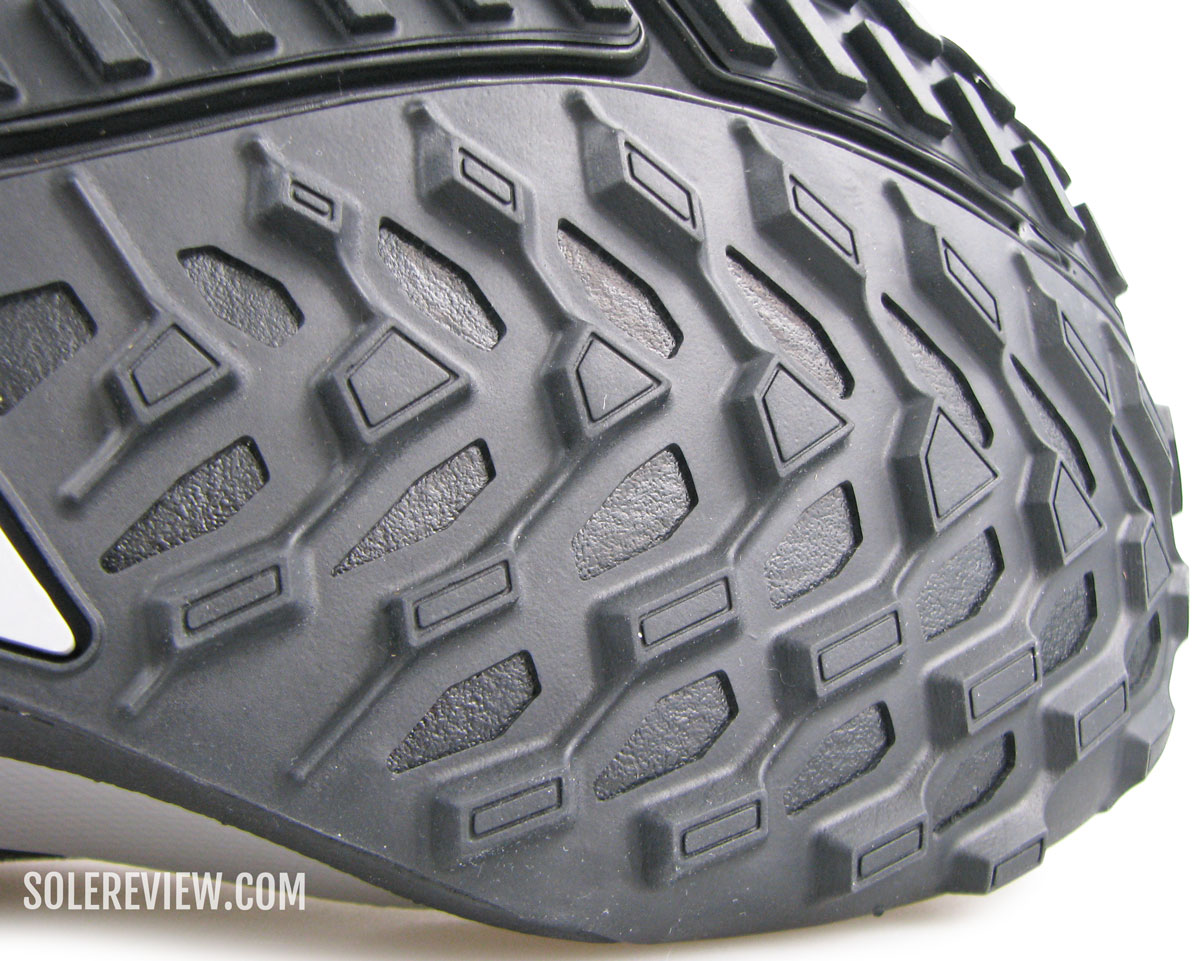
Unlike the Pegasus Trail 3, the new outsole has a thinner forefoot with windows. The lugs aren’t very deep, so the traction is good – but far from great.
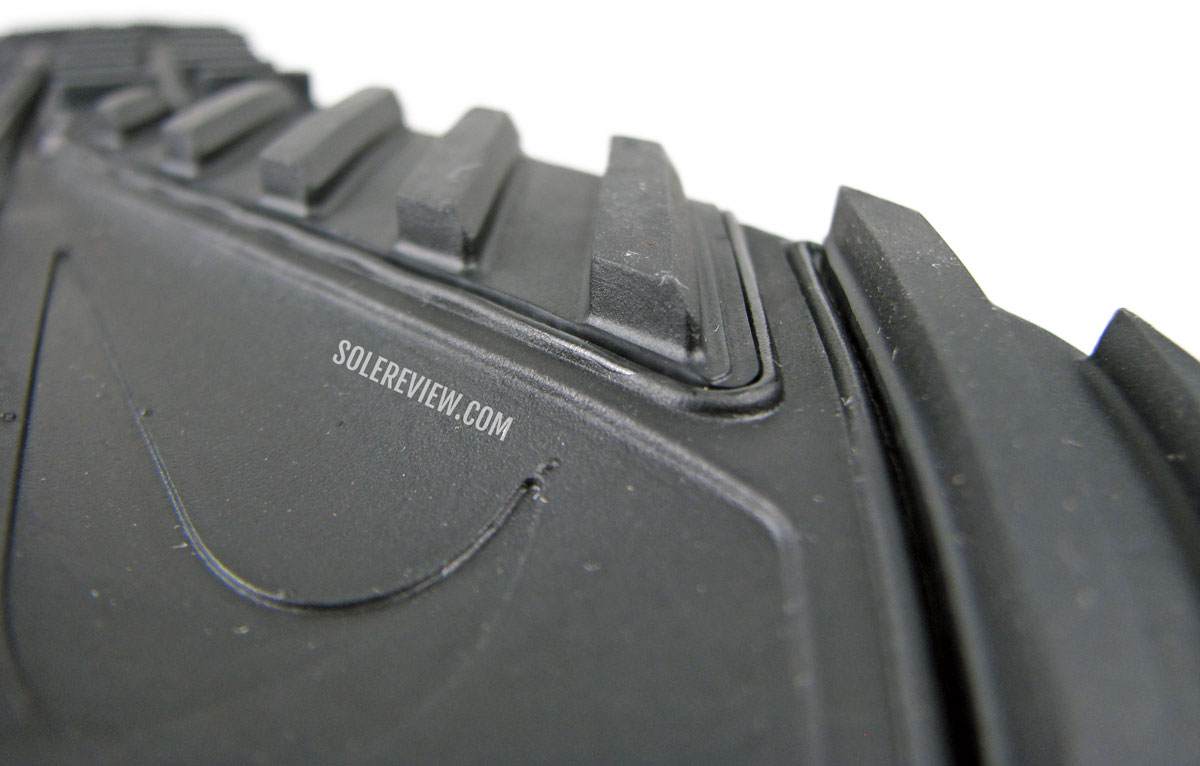
With the deeper lugs in the rear, the outsole grips better on downhill sections than on uphill climbs.
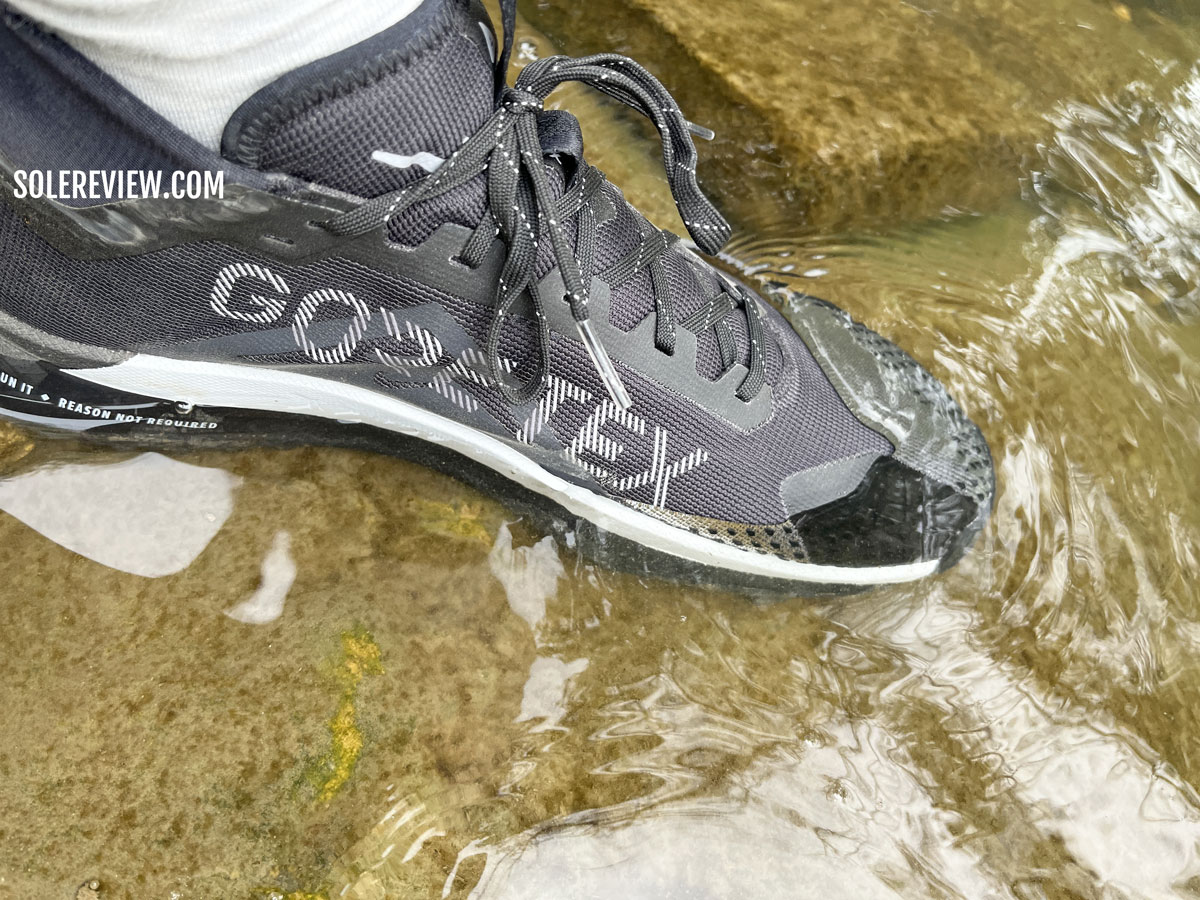
Like any outsole, wet or moss/algae covered rocks are a no-go.
The lugs are narrowly-spaced and relatively shallow, so this isn’t the outsole for muddy trails. Damp and slippery rocks are also off the menu. The traction is decent on dry trails, and the deeper lugs under the heel grip better during descent.
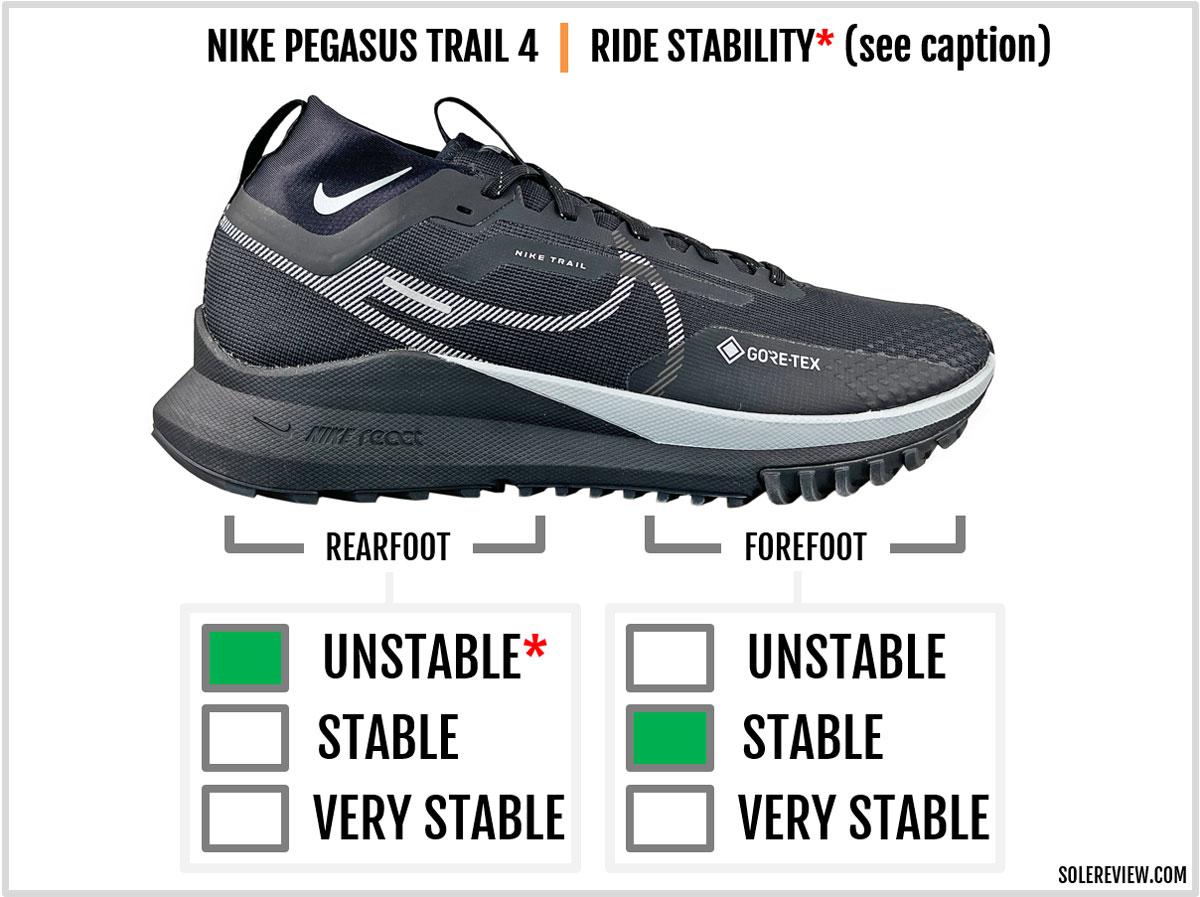
The Pegasus Trail 4 is stable enough on the road and flat trails. However, its stability suffers on bumpy terrain.
The lack of stability over rough trails is a problem. Though the midsole has a wide base, the slim upper heel doesn’t offer a lot of support. Going fast on bumpy terrain doesn’t inspire confidence.
Contrast this with a soft trail shoe like the Brooks Cascadia, and the difference is stark. The wider base of the Cascadia offers a much higher level of stability than the Pegasus Trail.
On the road, the cushy midsole delivers its best performance at running speeds of 5:30 min/km (8:50 min/mile) or slower.
The Pegasus Trail 4 weighs just 10.4 ounces for a half pair of US 10, which is respectable for its category. It’s worth noting that this is a marked improvement over the V3. We assume that removing rubber strips on the upper and changing the outsole helped the shoe shed those precious ounces.
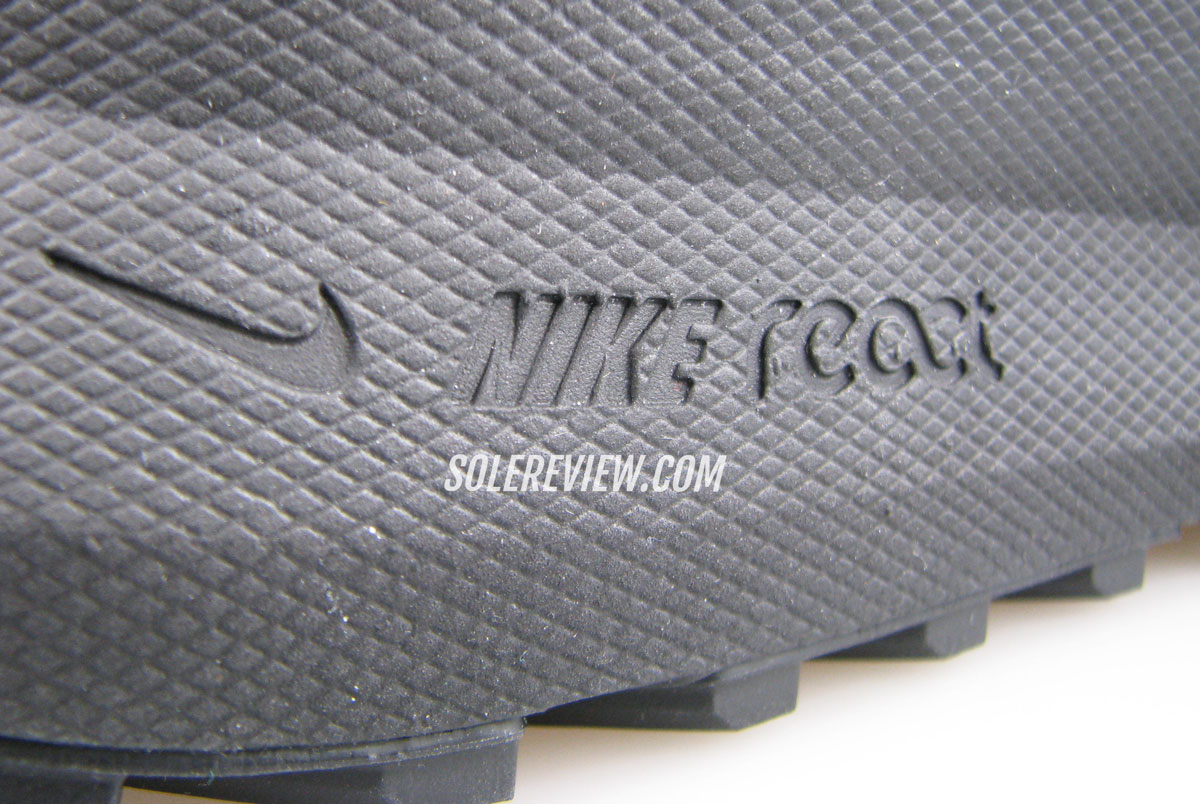
The Nike React foam is sensitive to ultra-cold temperatures. It’s softer during the summer and stiff when freezing.
Like most React-based shoes, the midsole turns harder in freezing temperatures. When that happens, the ride stability and midsole protection improve due to the stiffer midsole. That’s accompanied by a corresponding decrease in ride comfort.
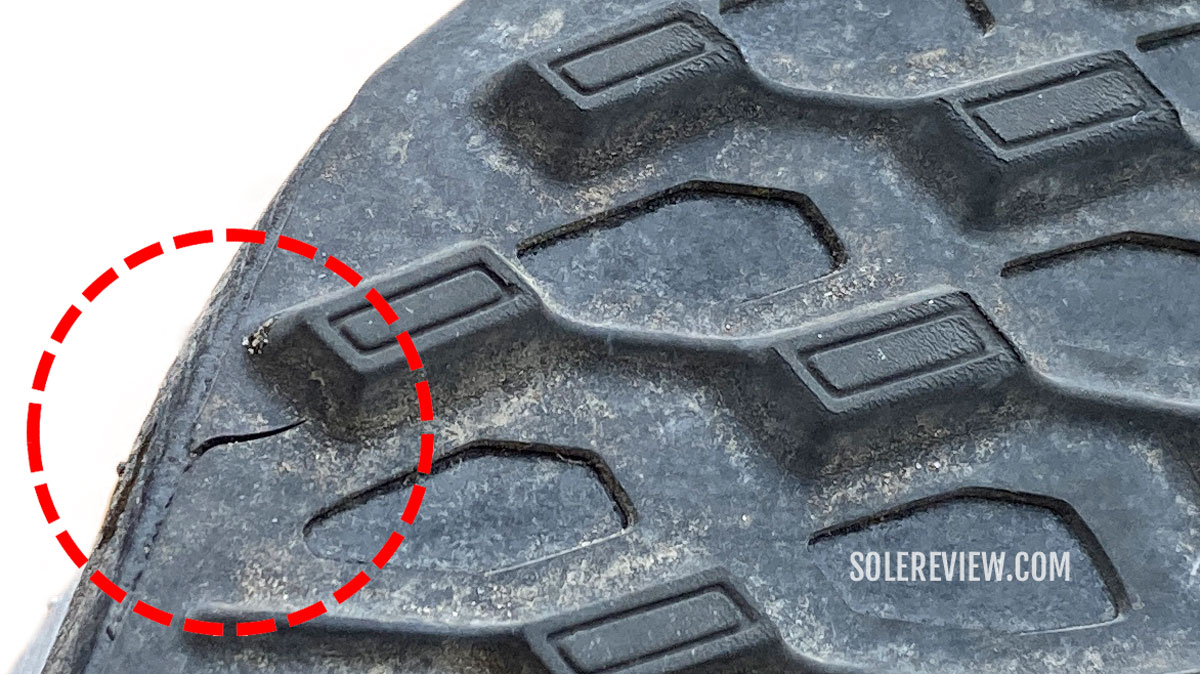
A small crack has formed on the thin outsole.
Based on our initial ownership period, the outsole appears to be less durable than the Pegasus Trail 2 and 3. There’s already a small tear appearing on the side, and the widely-spaced lugs have a higher probability of wearing down quicker than the older design.
THE UPPER DESIGN AND FIT

The standard variant has a Flywire midfoot with fewer overlays.
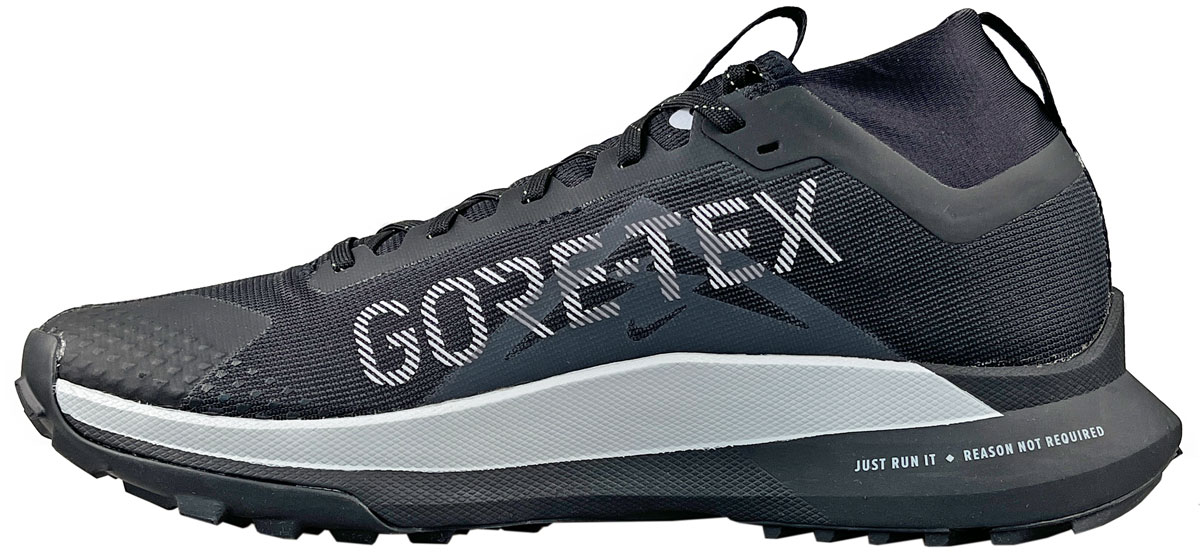
The GTX upper is designed very differently than the regular model.
The standard and waterproof variants of the Pegasus Trail 4 fit differently, so it’s worth spending time discussing both.
The non-GTX Pegasus Trail has a shallow toe-box, but fits true to size. The midfoot also fits better than the waterproof upper due to the Flywire lacing. The upper ventilation is excellent because of the large vents.
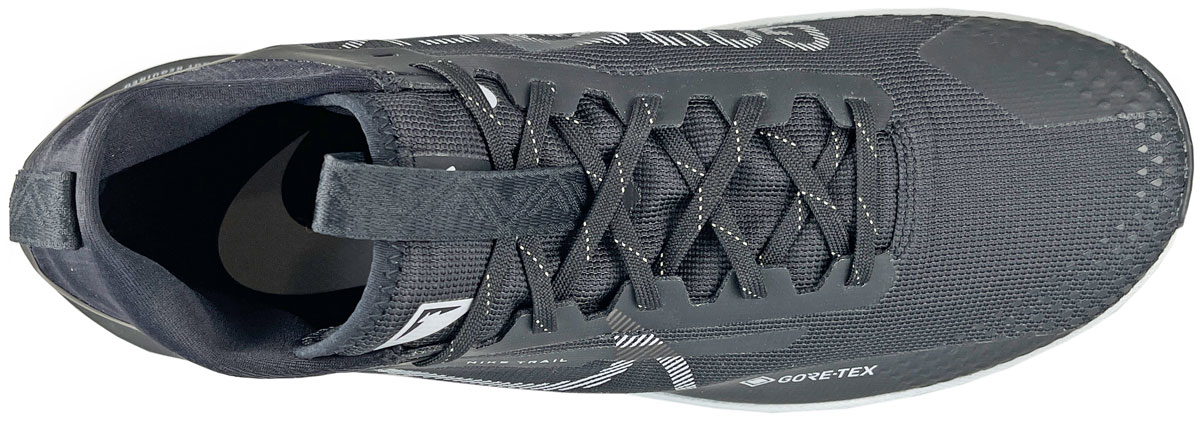
There’s no Flywire lacing on the GTX upper, and the upper fits short due to the heel padding.
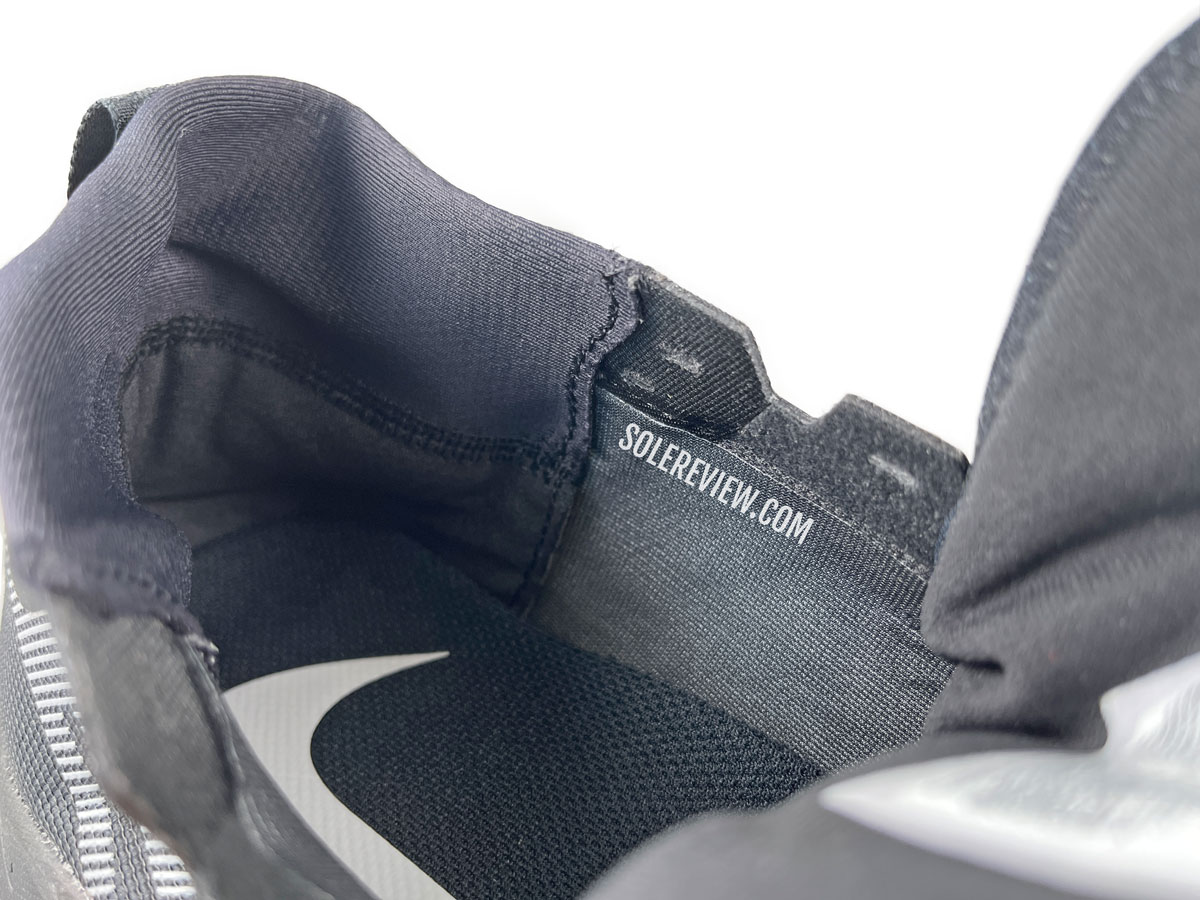
It’s hard to tell from this picture, but the heel is generously padded with foam. As a result, the grip of the GTX upper is excellent – but that comes at the cost of interior space.
In contrast, the Nike Pegasus Trail 4 Gore-Tex has a fit profile that’s a half-size short.
This means that you need to buy a US 9.5 instead of your usual US 9. We believe this has to do with the aggressive collar padding that repositions the foot forward.
As far as the heel grip is concerned, it’s excellent – the hard internal counter also helps. It’s easily the most secure part of the upper, because the midfoot and forefoot have a relatively easygoing fit.
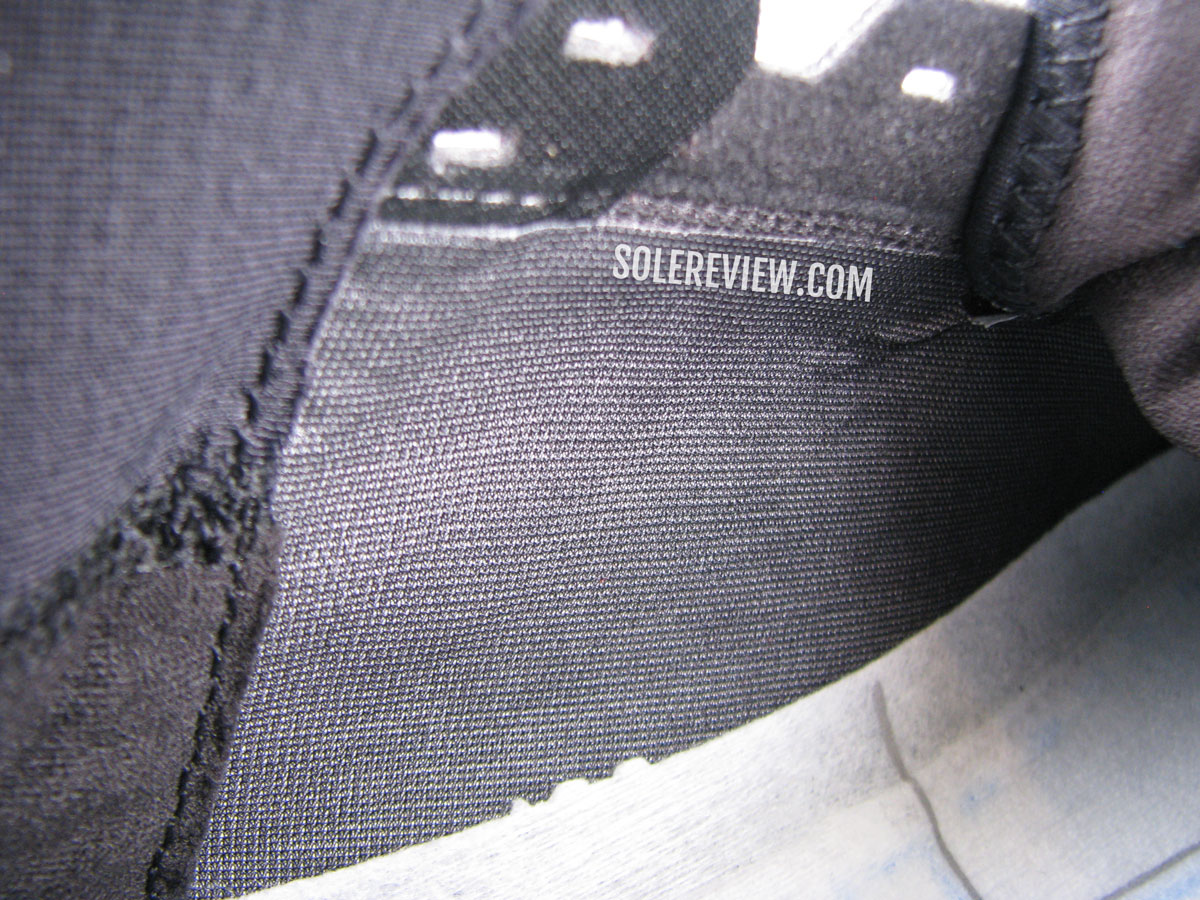
There is no Flywire on the Gore-Tex upper, so the midfoot fit doesn’t feel quite as locked in. Also note that the upper is not fully sleeved, so there’s a defined ‘waterline’, so to speak.
The GTX upper lacks the Flywire lacing of the standard version, so the midfoot never feels quite locked in. Pulling on the laces only tightens the top, as there’s no separate sleeve inside.
Recent advancements in the Gore-Tex membrane have made it a lot thinner, so the waterproofing doesn’t come at the cost of interior space. Gore-Tex calls this the ‘Gore Invisible Fit’.
So if we had to sum up the fit of both the Pegasus Trail versions, it would look something like this:
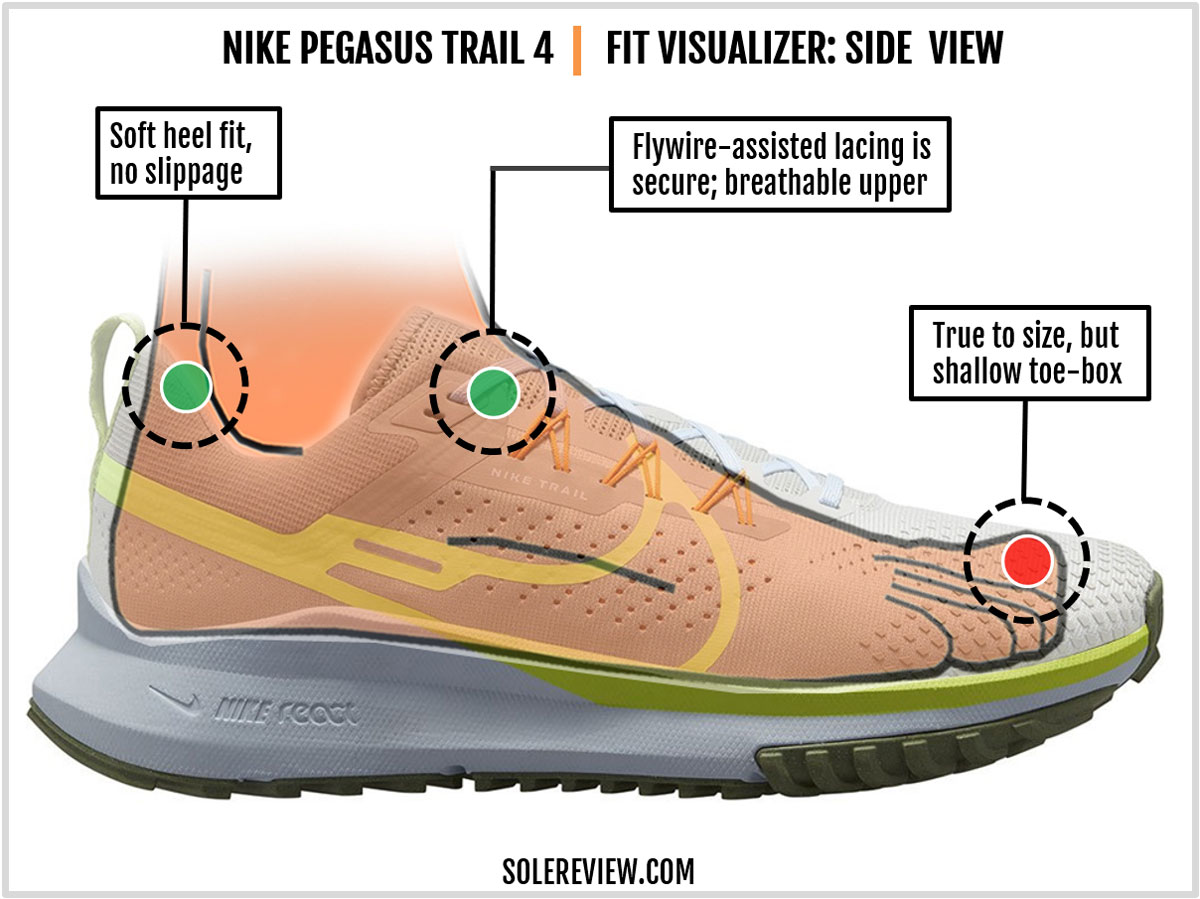
The standard model has an edge over the GTX upper fit because of the Flywire cords.
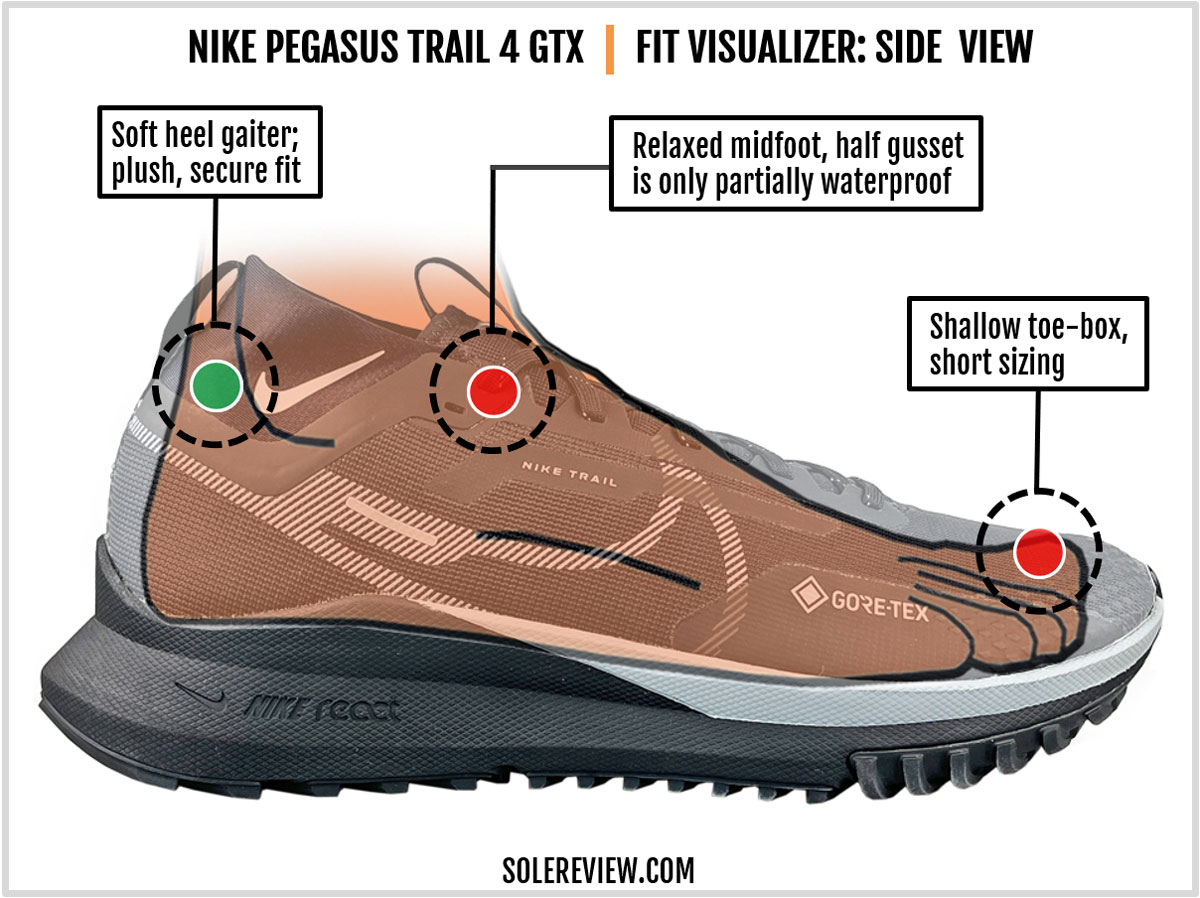
The Gore-Tex upper fits differently than the regular version.
As you can see, there’s a noticeable fit difference between the two Pegasus Trail models. The forefoot and toe-box fit can be summed up in the following infographics.
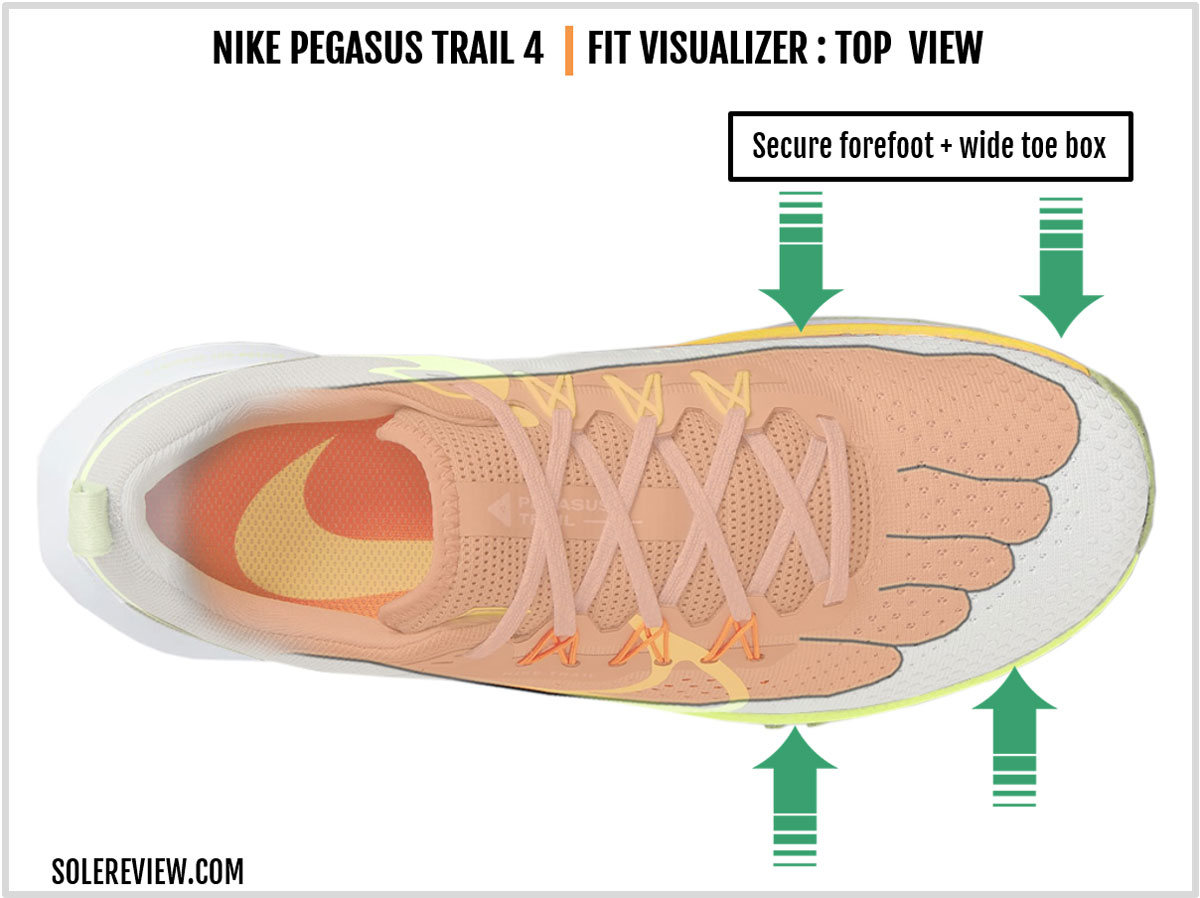
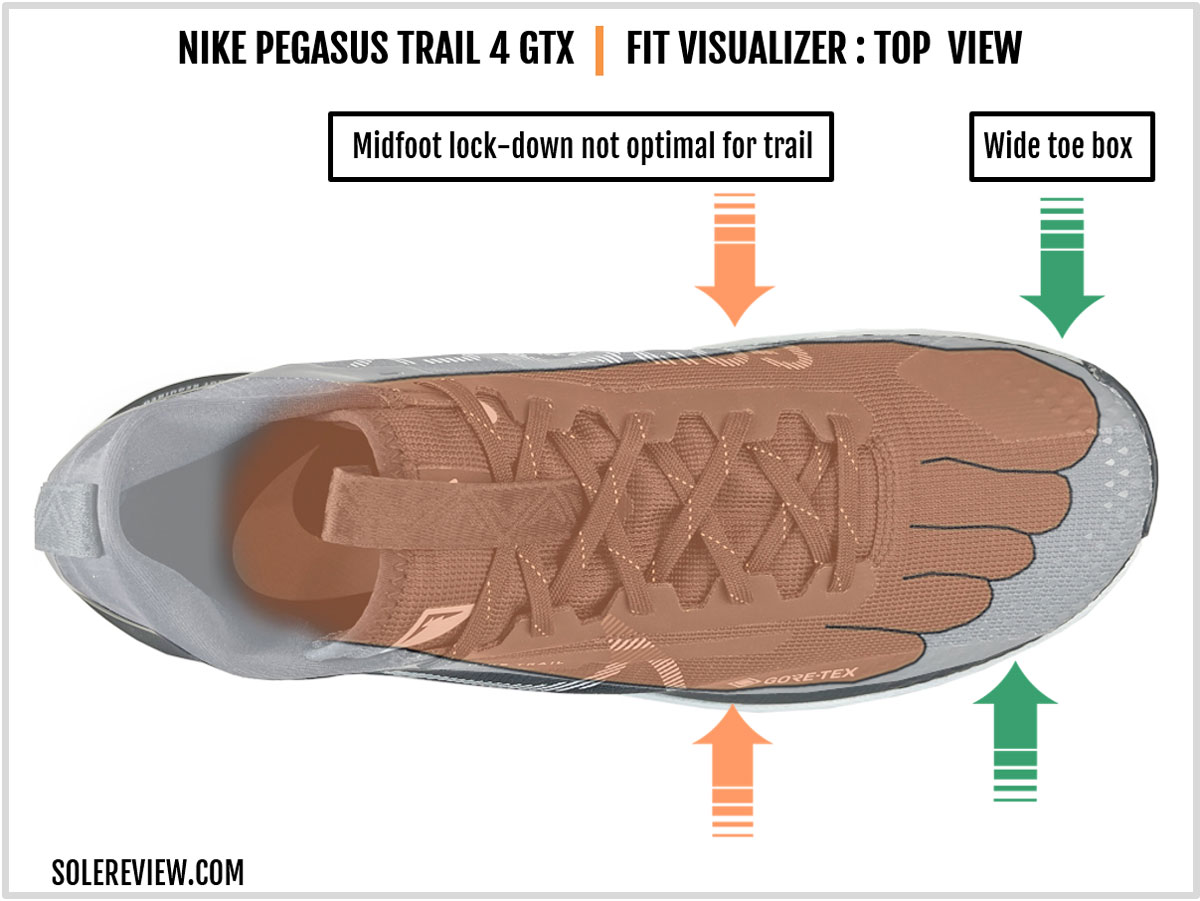
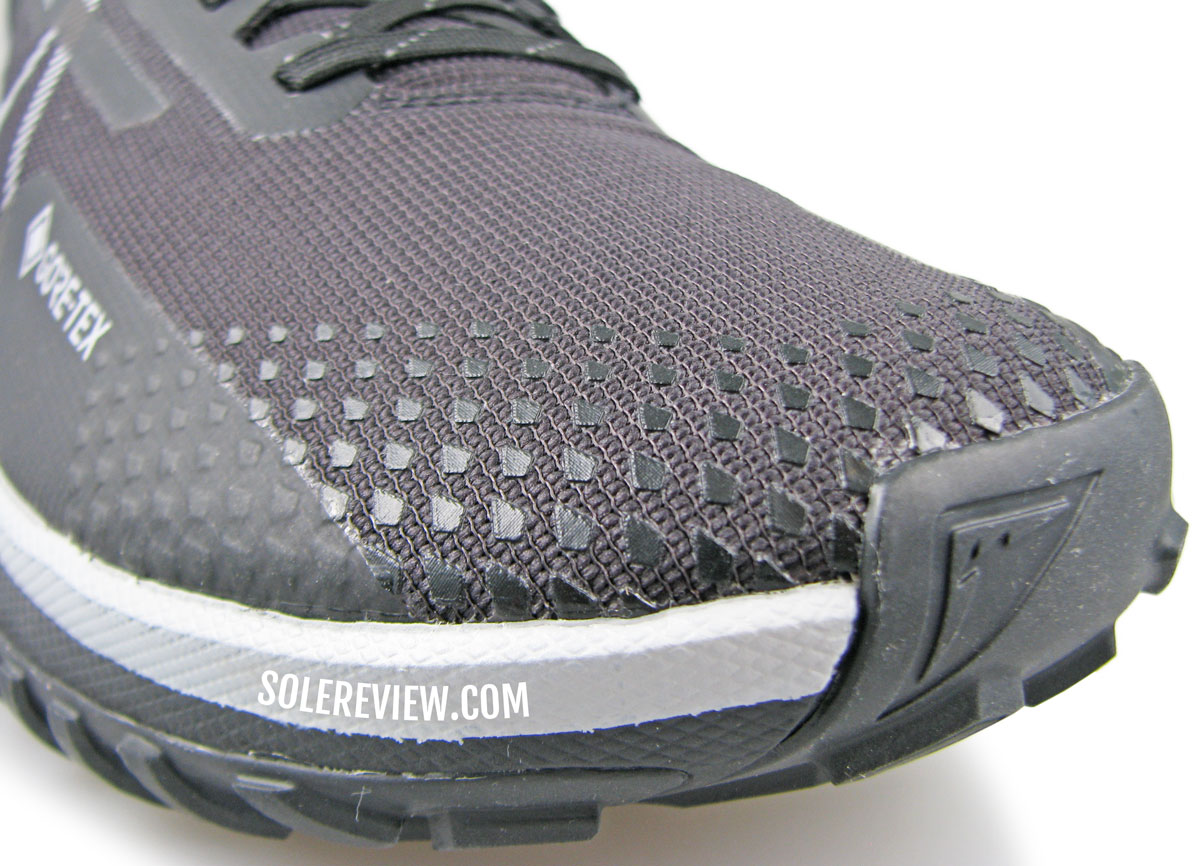
The Pegasus Trail 4’s toe-box is shallow – more so on the GTX version, thanks to the fused overlay and sizing difference.
On both shoes, the toe-box is slightly shallow. The GTX upper has a protective layering over the big toe that adds a bit of shallowness, but the shorter sizing is mostly due to the heel padding.
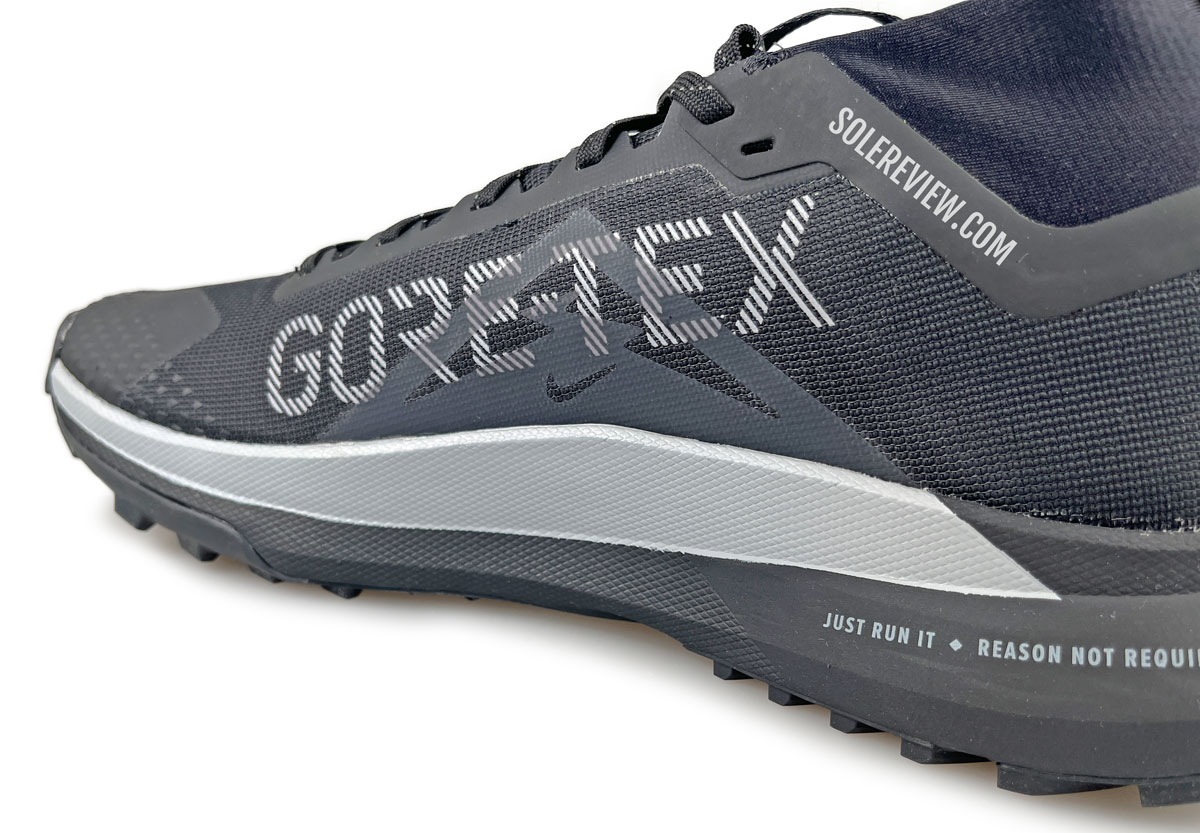
The inner side of the upper is reinforced with a fused laminate.
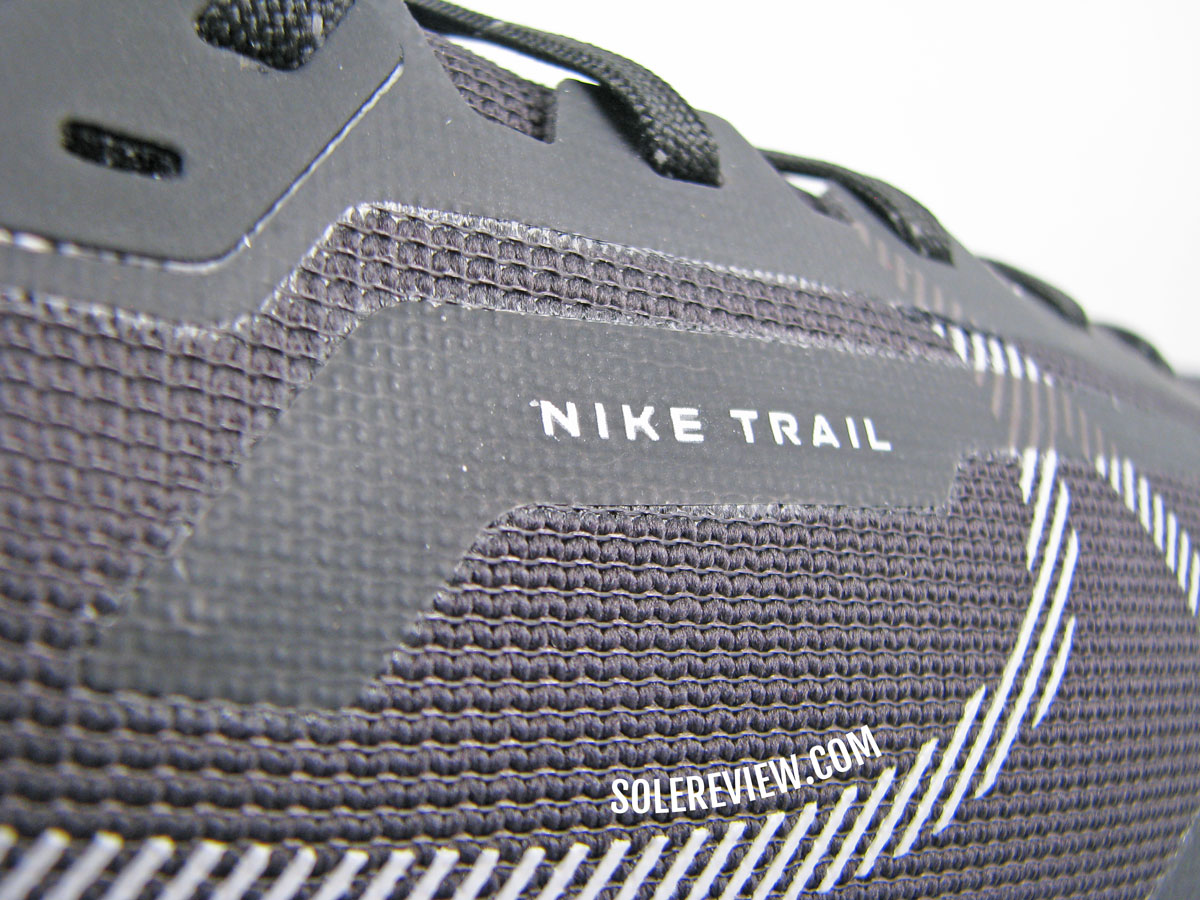
Other parts of the upper – like the lacing panel – get reinforced with overlays.
The GTX upper has a more protective exterior over the standard Pegasus Trail. The inner midfoot is reinforced, and so are the areas near the lacing and heel.
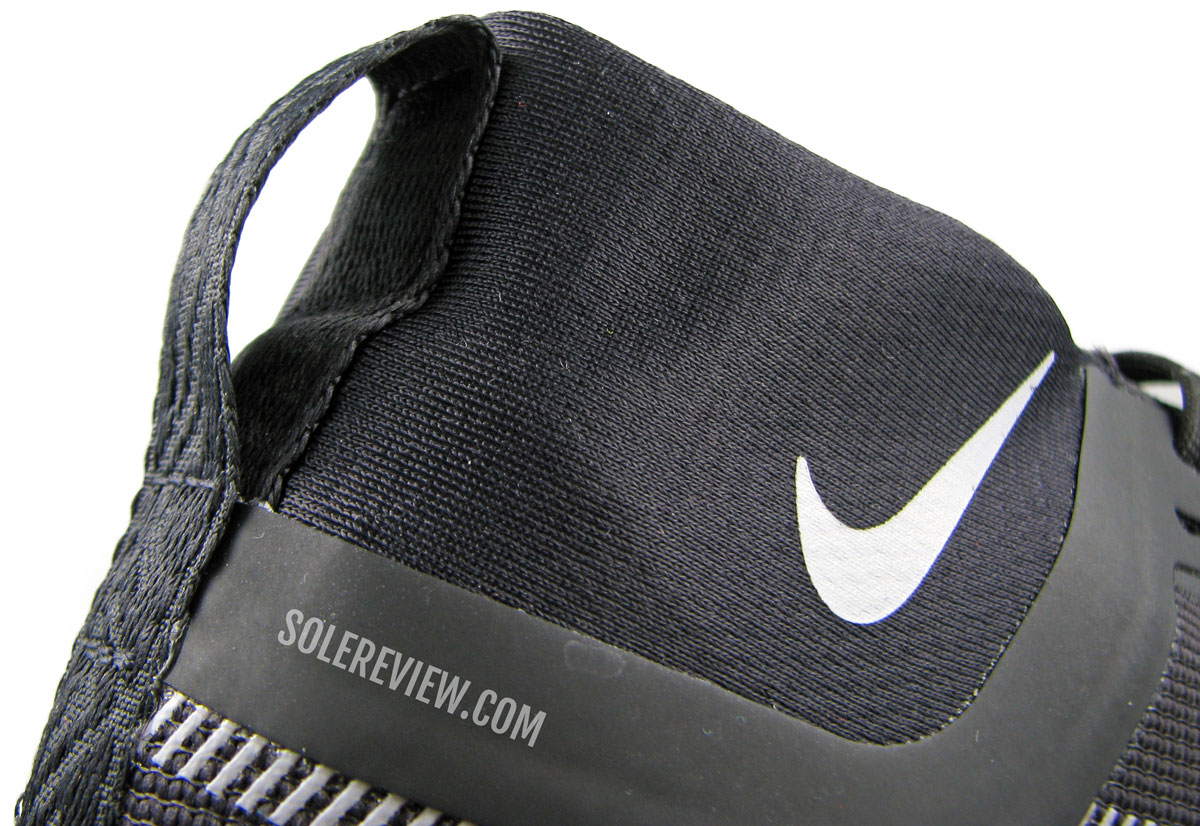
The debris-blocking mock gaiter returns. This is not waterproof, so it will absorb moisture.
The heel ‘mock’ gaiter is another feature that differentiates the Gore-Tex upper.
It’s a soft sleeve made of slightly elastic mesh that is effective at keeping the debris and dust out. By the way, the upper lacks a D-ring in the front for a gaiter attachment.
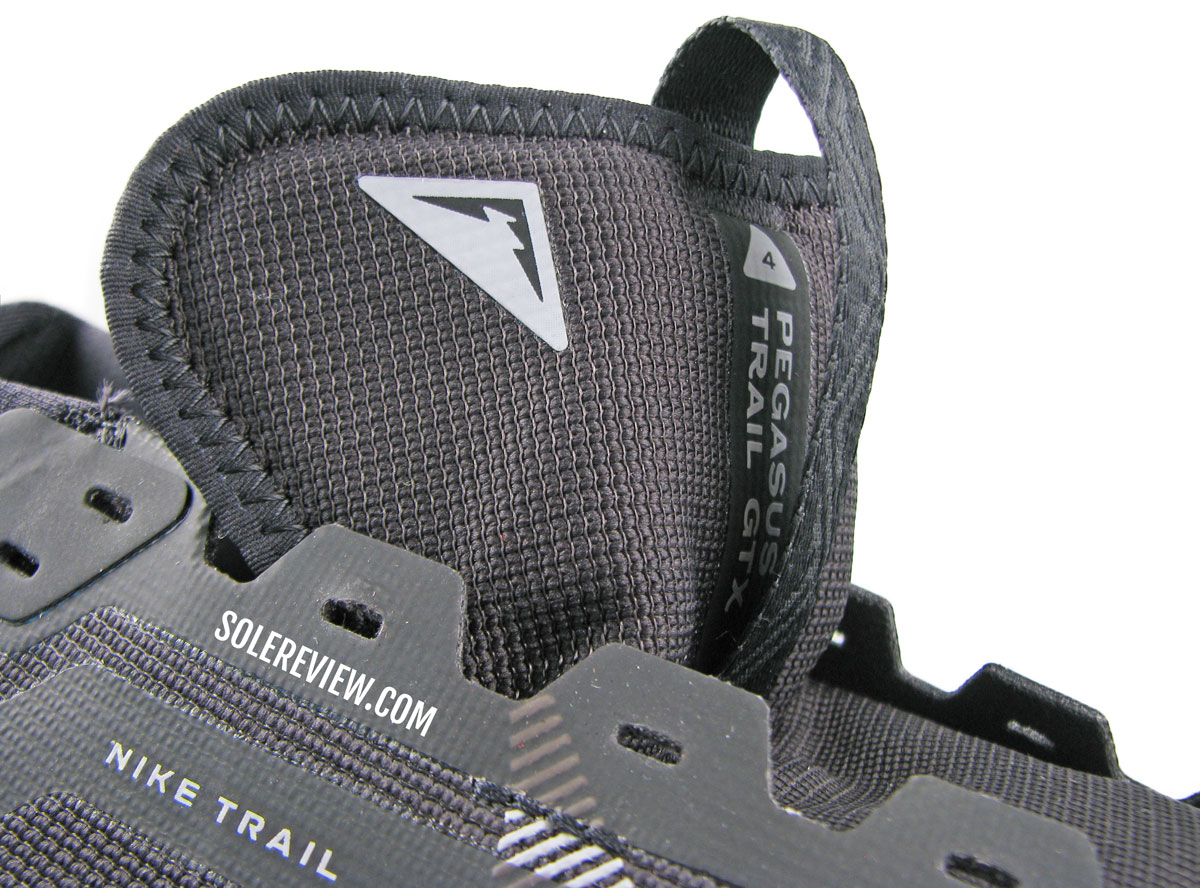
The large loop is functional and helpful; the tongue has a light foam fill.
Another feature that’s provided on the GTX model is the large loop over the tongue. It helps pull the slightly-padded tongue over the instep. The dimensions of the heel pull tab also make it fully functional.
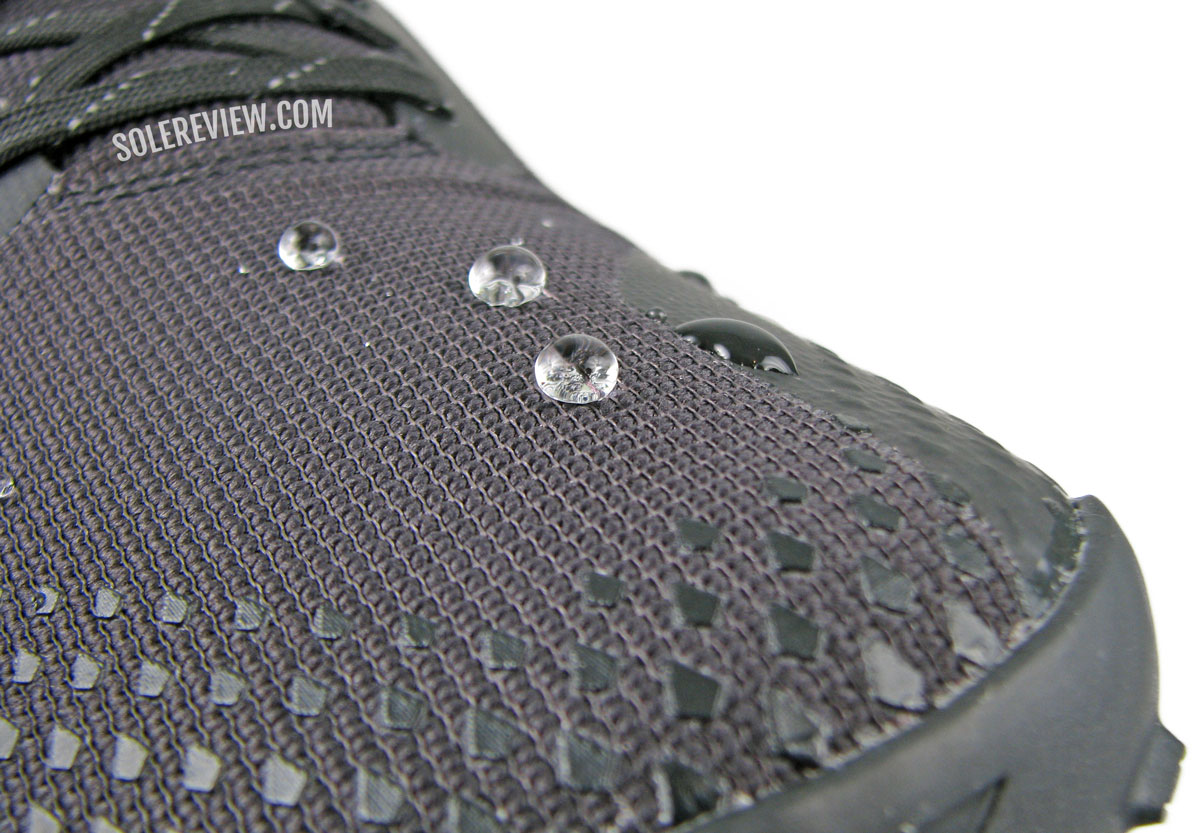
The waterproof upper prevents the water from sticking.
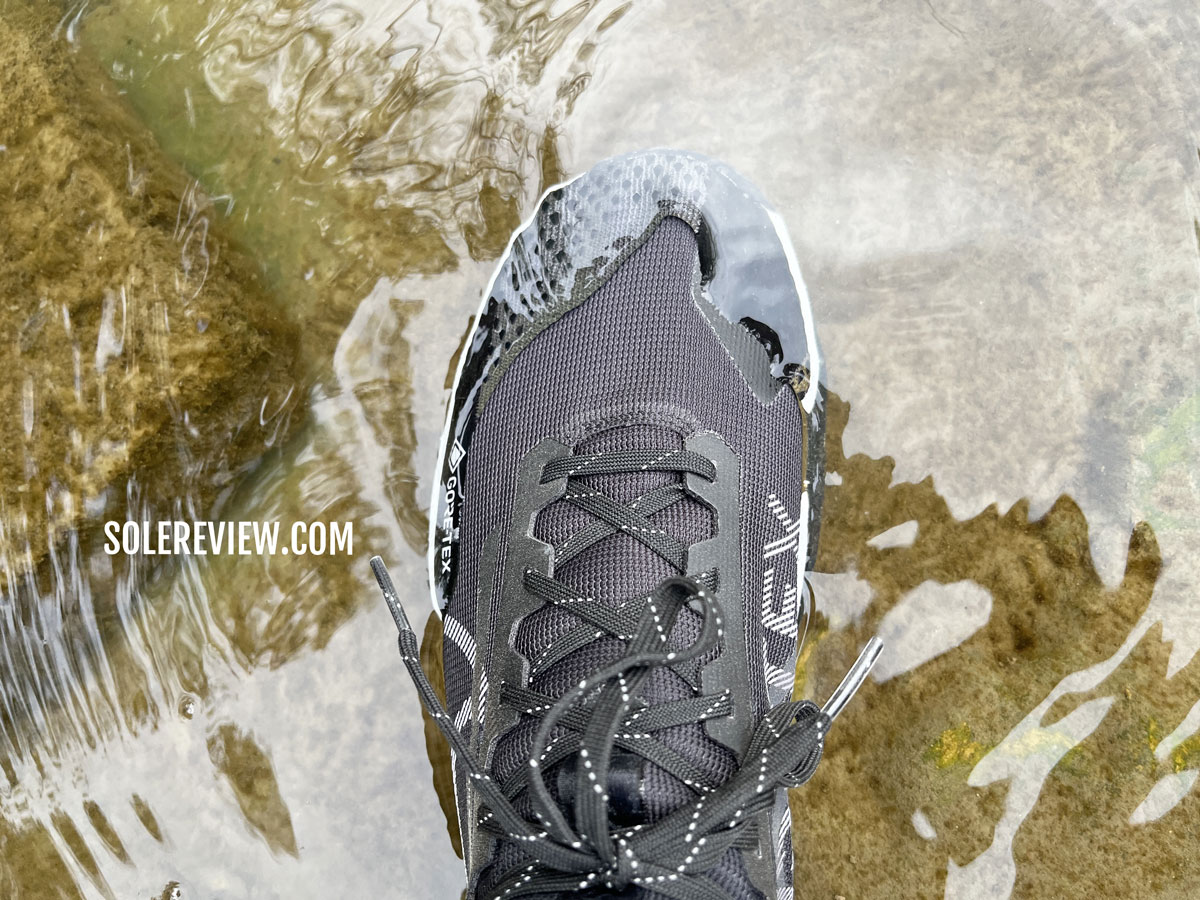
The upper is waterproof over the forefoot and half of the midfoot. Given the absence of a waterproof sleeve, submerging the shoe above the laces will soak the insides.
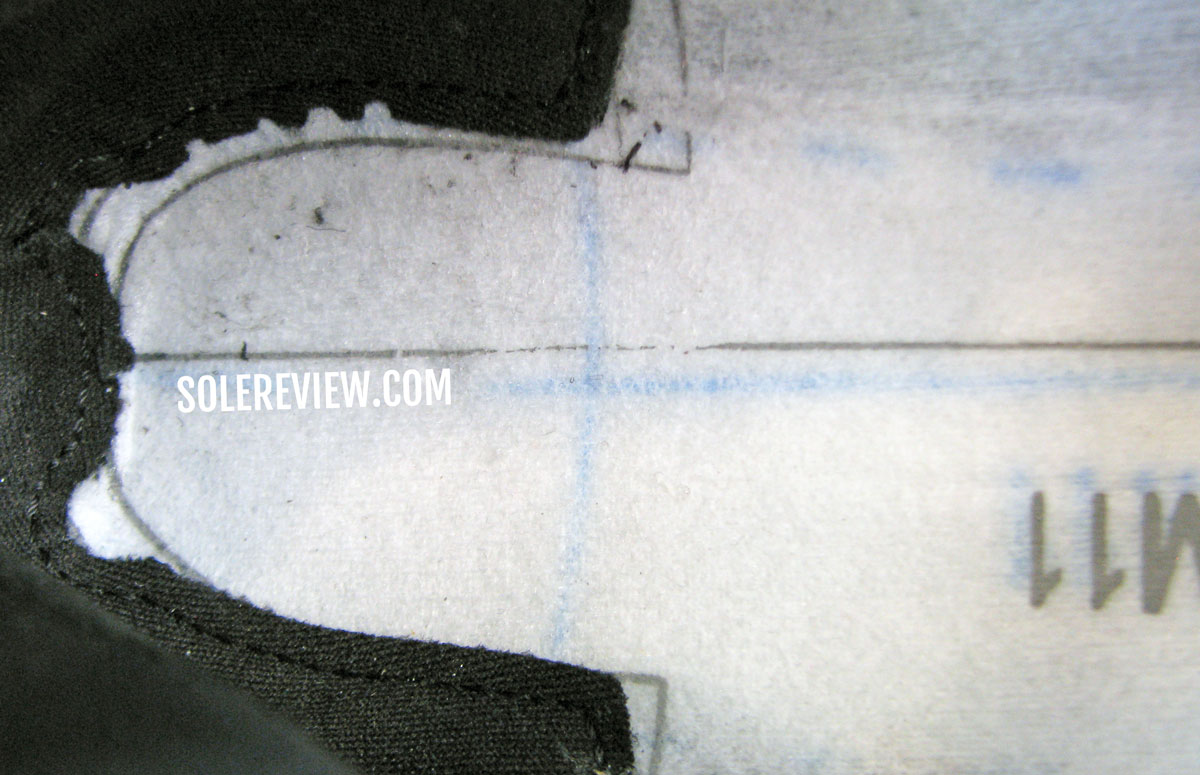
While the Gore-Tex upper doesn’t have bootie-style entry, the waterproofing is excellent. The water beads off the upper, and brief submersion in shallow water or puddles do not lead to moisture getting inside the shoe. Just make sure that the water-line is below the lacing panel. The heel gaiter is not waterproof, and there’s no sleeve inside.
The same goes for runs in light rain-showers as well. As long as it’s not a nasty downpour, the GTX upper does a good job of keeping the feet dry.
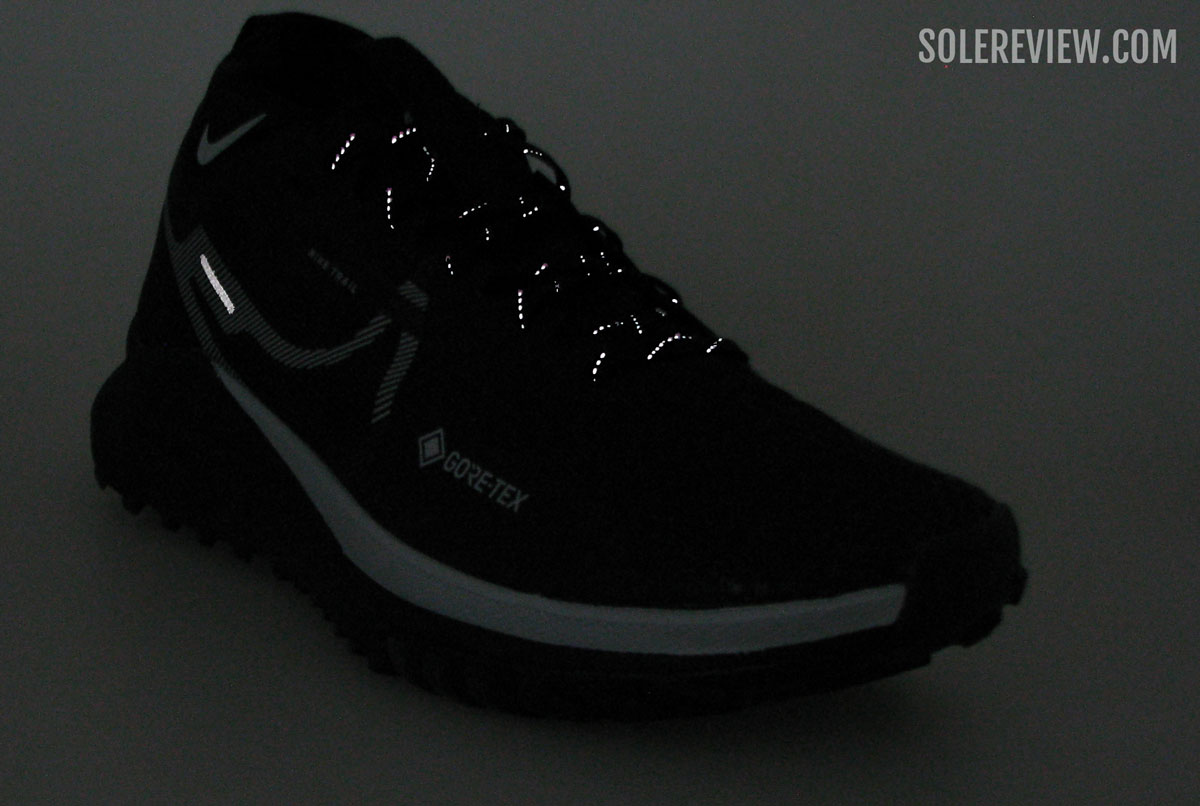
There’s only a trace amount of reflectivity on the laces and upper, so get the Pegasus 39 Shield instead for a higher level of low-viz elements.
PROS AND CONS

Most runners will appreciate the soft ride comfort during long runs on flat trails and roads. The GTX variant is effective at keeping moisture out, so it’s an excellent all-season running shoe.
However, calling it a proper trail shoe wouldn’t be accurate. The low levels of stability and outsole protection on uneven terrain means that the term ‘trail’ is a bit of a stretch. Also, the midfoot fit security (on the GTX version, the standard model is fine) lacks the lock-down that’s required on rough trails.
The React foam ‘reacts’ differently to freezing winters, meaning that you’ll have a stiffer shoe during the colder months. We were really hoping for the Pegasus Trail 4 to feature a gaiter D-ring, but Nike chose not to provide one.
SHOES SIMILAR TO THE NIKE PEGASUS TRAIL 4
We don’t have any miles on the Nike ZoomX Zegama yet, so we can’t say how it compares with the Pegasus Trail 4.
If you want better stability and trail worthiness, the New Balance Hierro V7 is a great alternative. It’s got a comfortable Fresh Foam midsole over a Vibram outsole that works equally well on the road and non-technical trails. The soft upper fits securely, and is offered in a waterproof Gore-Tex edition as well.
The Salomon Ultraglide is also an effective dual-purpose shoe. It’s not an aggressive trail runner like the Speedcross, and is softer as well. The supportive ride and single-piece Contagrip sole are suitable for mild trails.
From Hoka, there’s the Challenger ATR 6. While it’s not as hyped as the Pegasus Trail 4, it’s an underrated shoe that does road and trail duties equally well. The midsole is neither too soft nor too firm, thus making it ideal for trail and concrete runs.
If you’re looking for a shoe with a rock shield, the Brooks Cascadia 16 offers that – along with a cushioned midsole that’s comfortable enough for road miles.
On the zero-drop side of things, the Altra Timp 4 is your shoe. It’s not exactly a road-trail kind of running shoe, but it’s comfortable enough on concrete and rugged enough for the trail.
Do you own this shoe? Improve this review by sharing your insights – submit a review here.
